SPECIAL TOPIC—Two-dimensional magnetic materials
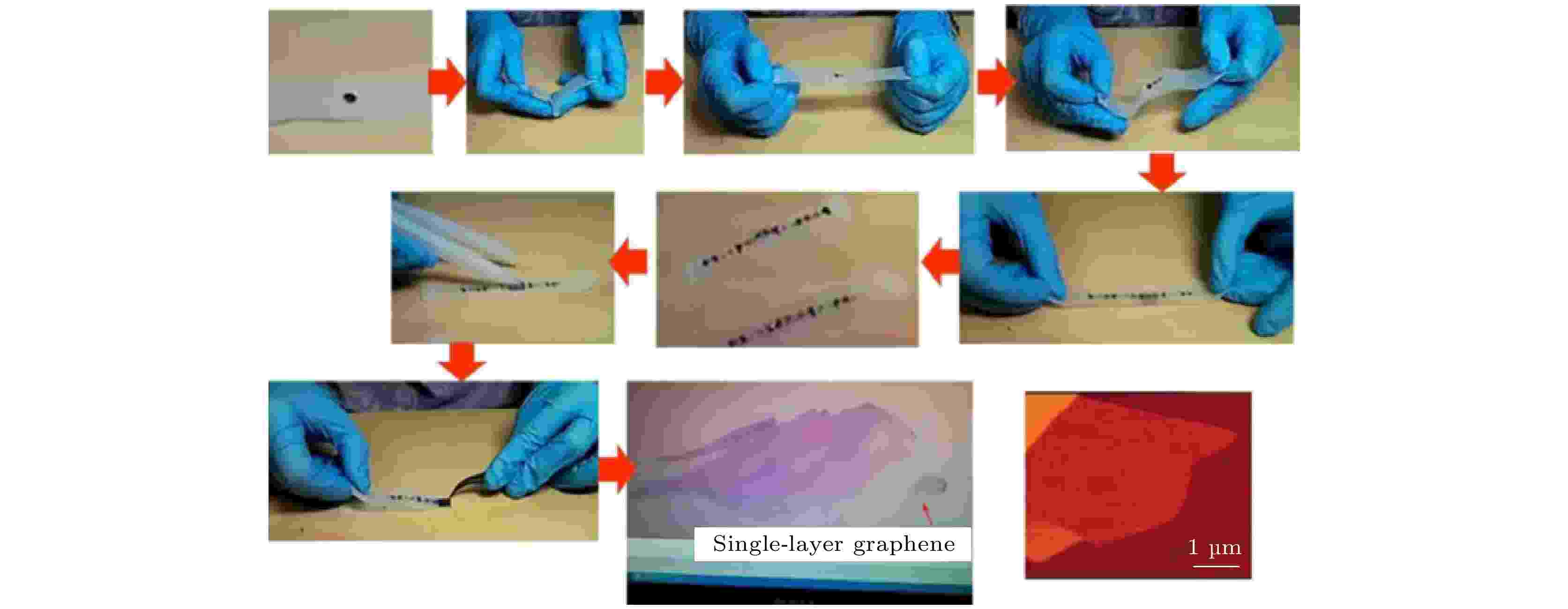
2021, 70 (12): 127301.
doi:10.7498/aps.70.20210223
Abstract +
To date, despite the continuous improvement of integrated circuit manufacturing technology, it has been limited by quantum effects and the shrinking of device size has caused the industry to encounter bottlenecks such as low reliability and high power consumption. The “Moore’s Law” that has lasted for nearly 50 years in the microelectronics industry will not be sustainable. In 2004, the advent of graphene, a two-dimensional (2D) material, brought new opportunities to break through the power consumption bottleneck of integrated circuits. Due to the low dimensionality, 2D materials exhibit a variety of fasinatingly electrical, ferromagnetic, mechanical, and optical properties at an atomic level. Among them, ferromagnetism has a wide range of applications in information processing, magnetic memory and other technologies. However, only a few 2D ferromagnetic materials are successfully synthesized. Meanwhile, the magnetic long-range order will be strongly suppressed within a limited temperature range due to thermal fluctuations, and thus bringing non-ignorable limitations and challenges to subsequent work. Therefore, the realization and control of room-temperature ferromagnetism in 2D magnetic materials is the major concern at this stage. In light of the above, this review first introduces the development process, preparation methods and superior properties of 2D magnetic materials in detail, and then focuses on the methods of manipulating the Curie temperature of 2D magnetic material. Finally, we briefly give an outlook of the application prospects in the future.

2021, 70 (12): 127302.
doi:10.7498/aps.70.20210133
Abstract +
The intersection between layered magnetic materials and topological materials combines the advantages of the two, forming a material system with both the magnetic orders and topological properties within the minimum two-dimensional unit, i.e. layered magnetic topological materials. This type of material may host Dirac points, Weyl points, nodal lines, etc. which are associated with helical or chiral electronic states ranging from insulator, semimetal to metal. This results in lots of novel physical problems and effects, which attract much attention of scientists. In this paper, we focus our attention on intrinsic magnetic topological insulator, magnetic Weyl semimetal, magnetic Dirac semimetal, and take them for example to briefly review the interplay between magnetic orders and topological orders and recent experimental results. This emergent area requires further studies to explore more new material candidates, which is a challenging frontier of condensed matter physics.
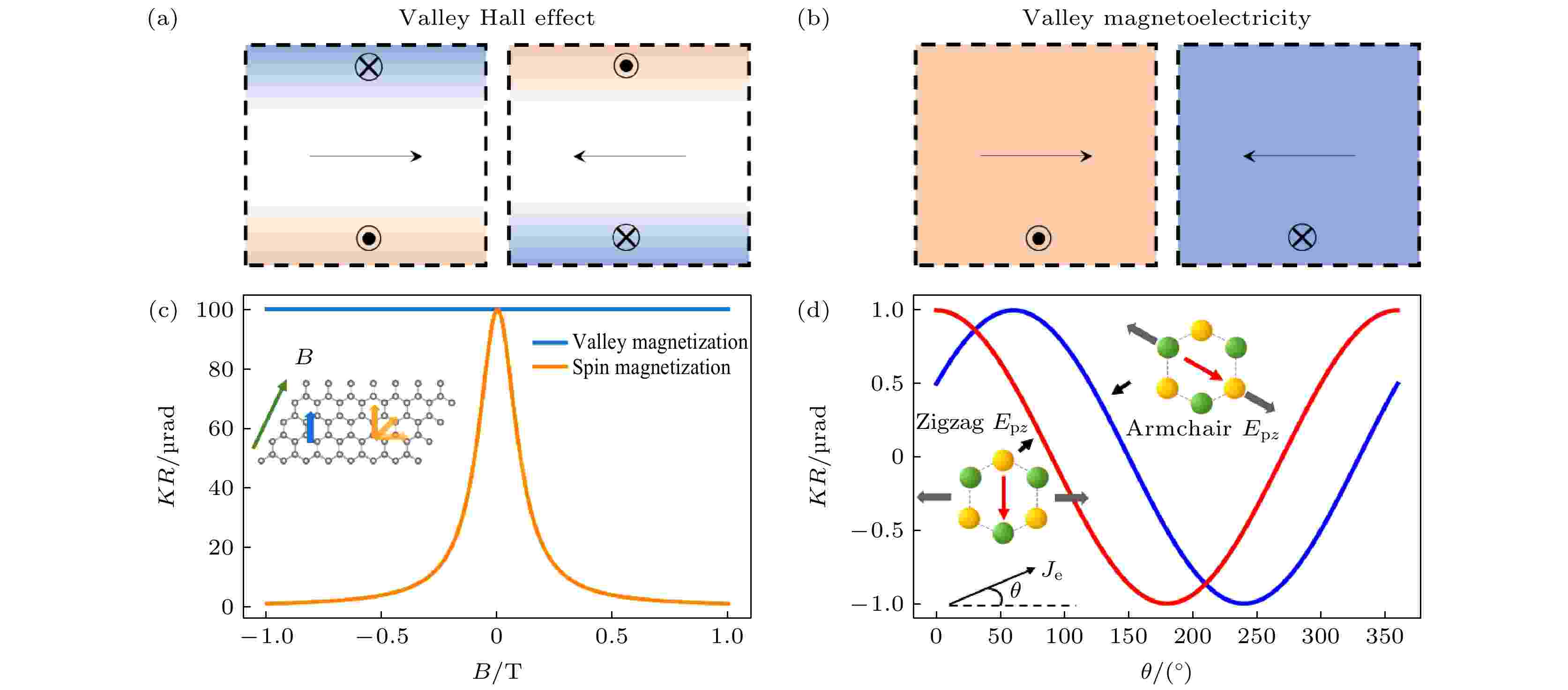
2021, 70 (12): 127303.
doi:10.7498/aps.70.20202132
Abstract +
The magnetic response in a two-dimensional material has received increasing attention in recent years. The magnetic effects and related quantum transport originate from Berry curvature, which is associated with crystal symmetry and many quantum effects including electrons’ orbital magnetism, spin-orbit coupling, and magnetoelectricity. The importance of studying the magnetic response in the two-dimensional material lies in two aspects. First, the magnetic response of two-dimensional material provides a platform to investigate the coupling between the above-mentioned intrinsic quantum effects and their couplings. Second, it possesses the potential applications in energy-efficient quantum and spintronic devices. Here, we review the experimental research progress made in recent years. In particular, we focus on the research progress of the valley Hall and magnetoelectric effect, quantum non-linear Hall effect, anomalous Hall, and quantum anomalous Hall effect in two-dimensional materials such as graphene, transition-metal chalcogenides, and twisted bilayer graphene. For each session, we first introduce these phenomena and their underlying physics by using crystal symmetries and band structures. Then, we summarize the experimental results and identify unsolved problems. At last, we provide an outlook in this emerging research direction.

2021, 70 (12): 127501.
doi:10.7498/aps.70.20210004
Abstract +
The spin-orbit torque generated by charge current in a strong spin-orbit coupling material provides a fast and efficient way to manipulate the magnetic moment in adjacent magnetic layers, which is expected to be used for developing low-power, high-performance spintronic devices. Two-dimensional materials have attracted great attention, for example, they have abundant species, a variety of crystal structures and symmetries, good adjustability of spin-orbit coupling strength and conductivity, and good ability to overcome the lattice mismatch to form high-quality heterojunctions, thereby providing a unique platform for studying the spin-orbit torques. This paper covers the latest research progress of spin-orbital torques in two-dimensional materials and their heterostructures, including their generations, characteristics, and magnetization manipulations in the heterostructures based on non-magnetic two-dimensional materials (such as MoS2, WSe2, WS2, WTe2, TaTe2, MoTe2, NbSe2, PtTe2, TaS2, etc.) and magnetic two-dimensional materials (such as Fe3GeTe2, Cr2Ge2Te6, etc.). Finally, some problems remaining to be solved and challenges are pointed out, and the possible research directions and potential applications of two-dimensional material spin-orbit torque are also proposed.

2021, 70 (12): 127503.
doi:10.7498/aps.70.20202204
Abstract +
The recently discovered two-dimensional magnetic materials have attracted tremendous attention and become a cutting-edge research topic due to their long-range magnetic ordering at a single-unit-cell thickness, which not only provide an ideal platform for studying the magnetism in the two-dimensional limit and other novel physical effects, but also open up a new way to develop low-power spintronics/magnetic storage devices. In this review, first, we introduce the crystal structures, magnetic structures and magnetic properties of various recently discovered intrinsic two-dimensional magnetic materials. Second, we discuss the research progress of controlling the magnetic properties of two-dimensional magnetic materials by magnetic field, electric field, electrostatic doping, ion intercalation, stacking, strain, interface, etc. Finally, we give a perspective of possible research directions of the two-dimensional magnetic materials. We believe that an in-depth understanding of the origin and mechanism of magnetism of the two-dimensional magnetic materials as well as the study of the relationship between magnetic properties and microstructures are of great significance in exploring a magnetic material with a substantially high Curie temperature (Néel temperature), and designing multifunctional new concept devices.
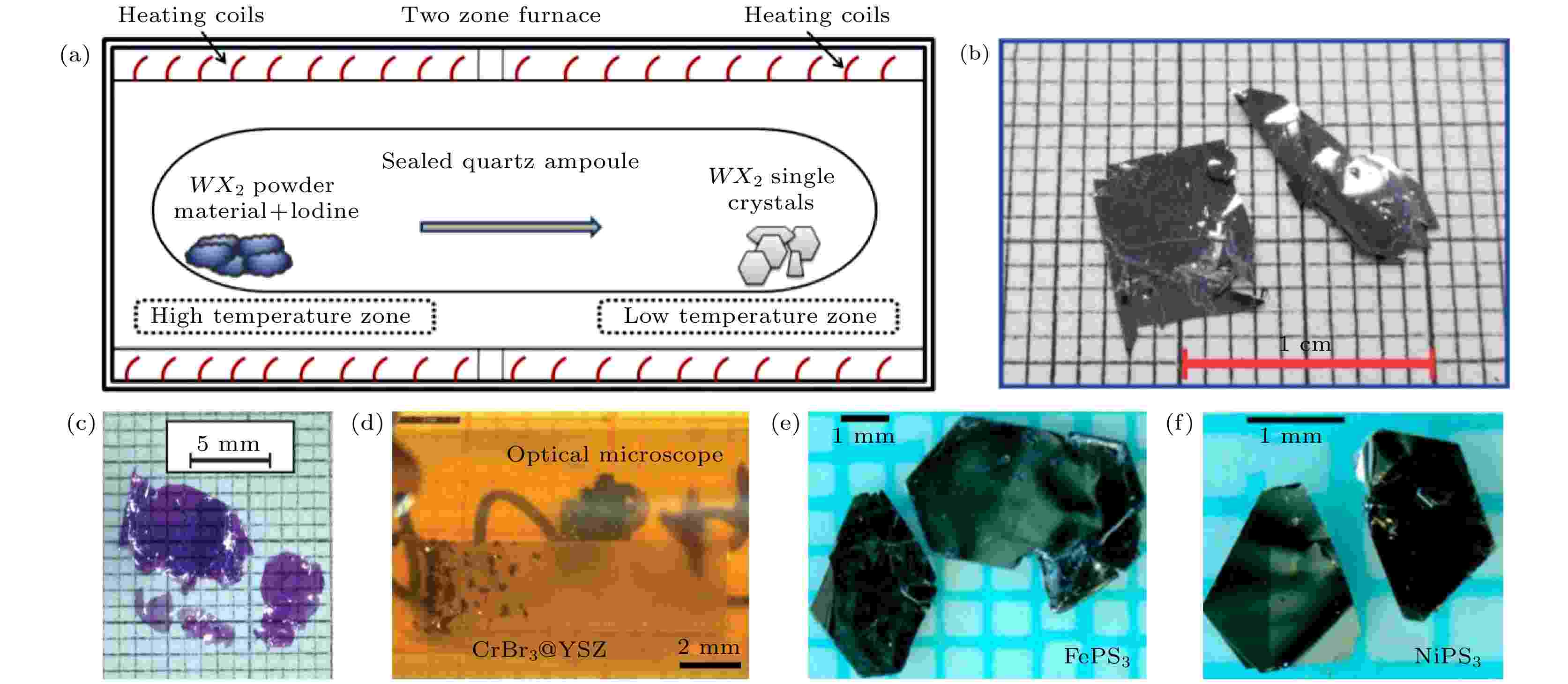
2021, 70 (12): 127504.
doi:10.7498/aps.70.20202197
Abstract +
For a long time, it has been generally acknowledged that low-dimensional (lower than three-dimensions) long-range orders cannot stay stable at any finite temperature, because temperature-induced fluctuations can destroy any long-range orders in low-dimensional systems supported by isotropic short-range interactions. However, this theorem requires that the interaction must be short-range and isotropic. In fact, many low-dimensional systems do not meet these two requirements. For example, due to the strong anisotropy in two-dimensional CrI3crystals, there is a band gap in the magnon spectrum. When the excitation energy from temperature is much lower than the band gap, the magneton cannot be excited by temperature on a large scale, and the long-range magnetic order in the two-dimensional system will not be destroyed. Various methods have been used to characterize the magnetic order in atomically thin CrI3crystals, and a lot of attempts have been made to manipulate the magnetic structure in the system. Focusing on CrI3, in this article we review the recent studies on growth, magnetic structure measurement and manipulation of two-dimensional magnetic materials, and also discuss the prospects for the next phase of research from the perspectives of basic condensed matter physics research and electronic engineering applications.
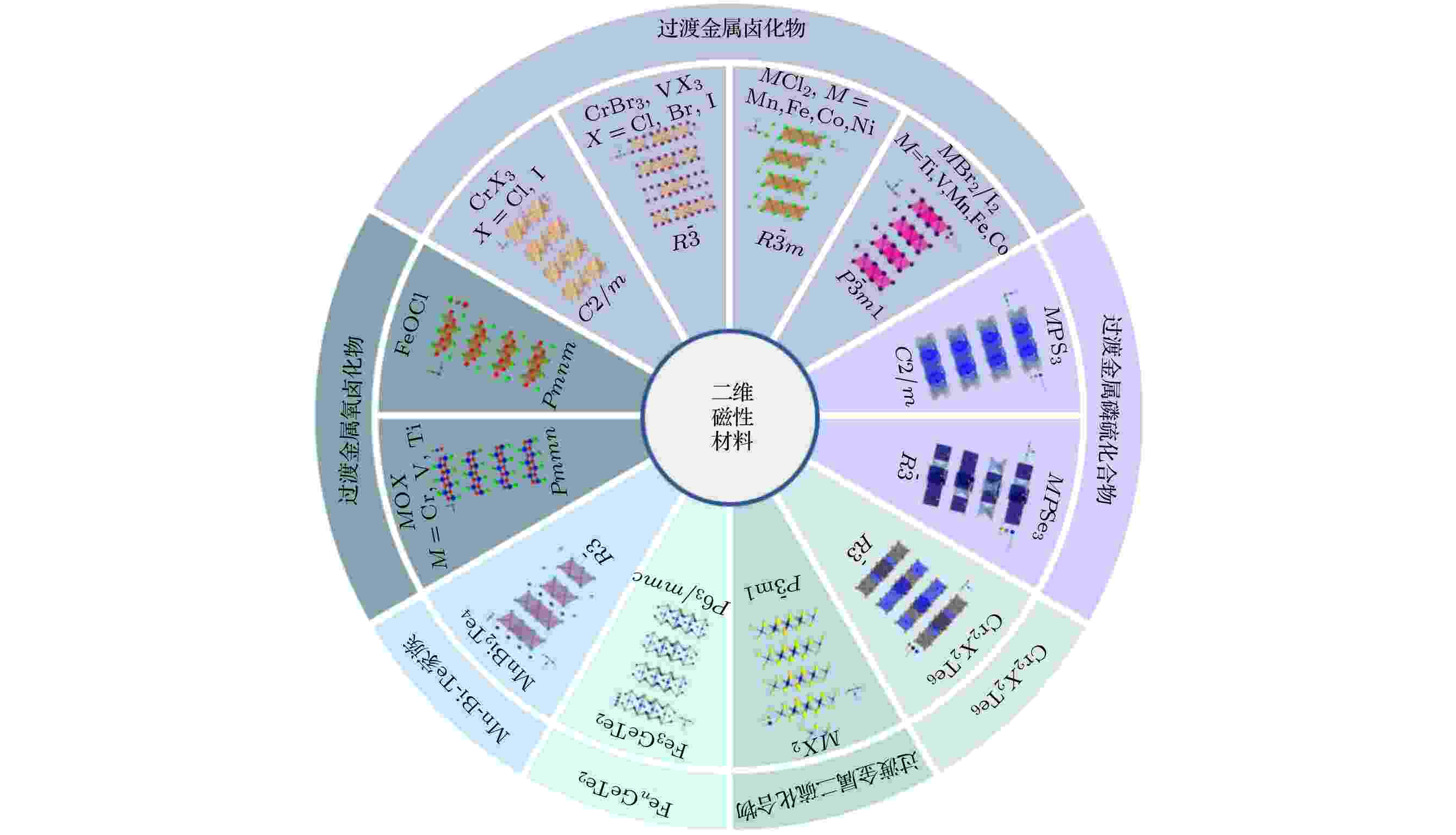
2021, 70 (12): 127801.
doi:10.7498/aps.70.20202146
Abstract +
Two-dimensional (2D) materials represented by graphene and molybdenum disulfide (MoS2) have attracted much attention in recent years due to their advantages in electrical, thermal, optical and mechanical properties. As a branch of 2D materials, 2D magnetic materials have special properties such as magnetic anisotropy and single-layer magnetic order. Especially, their magnetism can also be controlled by a variety of physical fields, and it possesses various physical properties and potential applications. Therefore, they have received widespread attention of researchers gradually. In this article, we summarize the types, synthesis methods, basic characteristics and characterization methods of 2D magnetic materials in detail, and the magnetism controlling of 2D magnetic materials as well. Finally, a simple outlook on the research directions and future challenges of 2D magnetic materials is given.

COVER ARTICLE
2021, 70 (12): 127502.
doi:10.7498/aps.70.20210042
Abstract +
The study of two-dimensional (2D) magnetic materials has driven the development of modern nano-electronic devices. Exploration of novel intrinsic layered materials with 2D magnetic order will provide a material candidate pool for fabricating 2D devices and searching for new quantum phases. Recently the layered antiferromagnetic (AF) topological insulators have aroused the great interest of researchers. As one of the proposed axion insulators, EuIn2As2exhibits a layered structure and 2D AF order. It is found that the parent compound EuIn2As2exhibits metallic behavior instead of the predicted insulating feature. To pursuit the predicted non-trivial topological state and novel feature, in this paper, we use various elements to dope the system to adjust the Fermi level. It is found that only Ca is successfully doped into the EuIn2As2system. The systematic transport and magnetization studies are performed on the single crystal of Eu1–xCaxIn2As2. The long-range AF order is revealed to be similar to the parent compound. Above the AF transition, the magnetization violated Curie-Weiss behavior and magnetoresistance keeps negative, indicating the ferromagnetic order. With doping nearly 20% non-magnetic Ca, the magnetic properties of the system barely change, which is favorable to keeping the former predicted nontrivial topological properties in EuIn2As2. Although Ca shares the same valence with Eu, the carrier density of Eu1–xCaxIn2As2is one order lower than that of EuIn2As2. The Ca doping brings electrons in and lifts the Fermi level. The results enrich the 2D magnetic material candidate pool and provide useful information for realizing the nontrivial topological state in the 2D AF system.

EDITOR'S SUGGESTION
2021, 70 (12): 129101.
doi:10.7498/aps.70.20202136
Abstract +
Recently, the discovery of intrinsic two-dimensional (2D) ferromagnetism has accelerated the application of spintronics in ultra-low power electronic device. Particularly, the Curie temperature of Fe3GeTe2can be improved to room-temperature in several ways, such as interfacial exchange coupling and ionic liquid gating, which makes Fe3GeTe2desirable for the practical application. In this work, we investigate the transport properties of Fe3GeTe2/graphene heterostructures with or without h-BN layers by utilizing the density functional theory combined with nonequilibrium Green’s function method. The results show that due to electronic orbital hybridization, the spin can be effectively injected into graphene with ± 0.1 V bias at the transparent contact interface of Fe3GeTe2/graphene. What is more, the efficient spin tunneling injection can be achieved in a wider bias range [–0.3 V, 0.3 V] by adding h-BN as a tunneling layer, where the spin filter effect that is induced by mismatched distribution of spin-dependent electronic states in the Brillouin zone, leads a spin polarizability to approach 100%. These results are helpful in the applications of 2D all-spin logic and the development of ultra-low power spintronic devices.
SPECIAL TOPIC—Terahertz biophysics
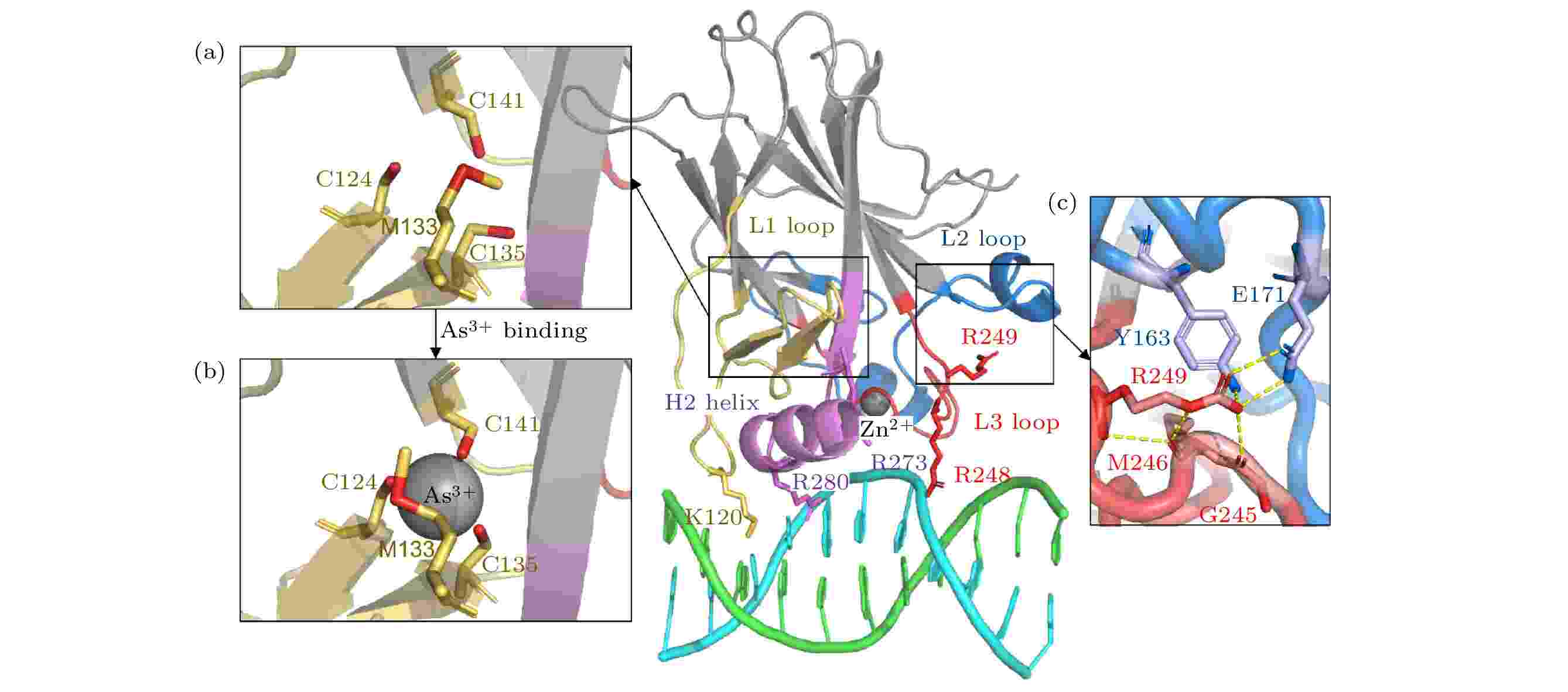
EDITOR'S SUGGESTION
2021, 70 (12): 128201.
doi:10.7498/aps.70.20210647
Abstract +
Recovering the protein activity of p53 mutants through small molecule ligand binding (eg. arsenic) is an important strategy for tumor suppressor therapy. However, the mechanistic basis on the changes of collective dynamics and their roles of p53 protein in functional recovery process has not been fully elucidated. Herein, the normal mode calculations based on all-atom elastic network model are employed to characterize the terahertz low frequency motions of core DNA-binding domain (p53C) which is essential for p53 protein activities in transcriptional transactivation. We find that the lowest-frequency collective vibration mode of the p53C mutant is effectively restored by the binding of arsenic (III) ligand. In R249S mutant, the L1 loop is stabilized through restricting the swing-out movement. The results obtained from atomic backbone fluctuations suggest that the arsenic binding can significantly improve the L1 loop and L2 loop fluctuations. The statistical analysis of low frequency vibration mode reflects that the arsenic-bound R249S mutant has an apparent recovery of frequency shift in the terahertz range. The residue-residue motion correlation also suggests that structural components binding to arsenic are dynamically coupled. In the H2 helix with arsenic-binding residues, the motions of C124, C135, M133 and C141, are correlated with the arsenic recovery. These results provide the terahertz biophysical mechanism for the recovery effect of arsenic (III) on the p53 protein activity and new evidence for the coupling of the low-frequency vibration characteristics of protein structures with its function, thus giving a new physical insight into the p53 related cancer therapies.
REVIEW
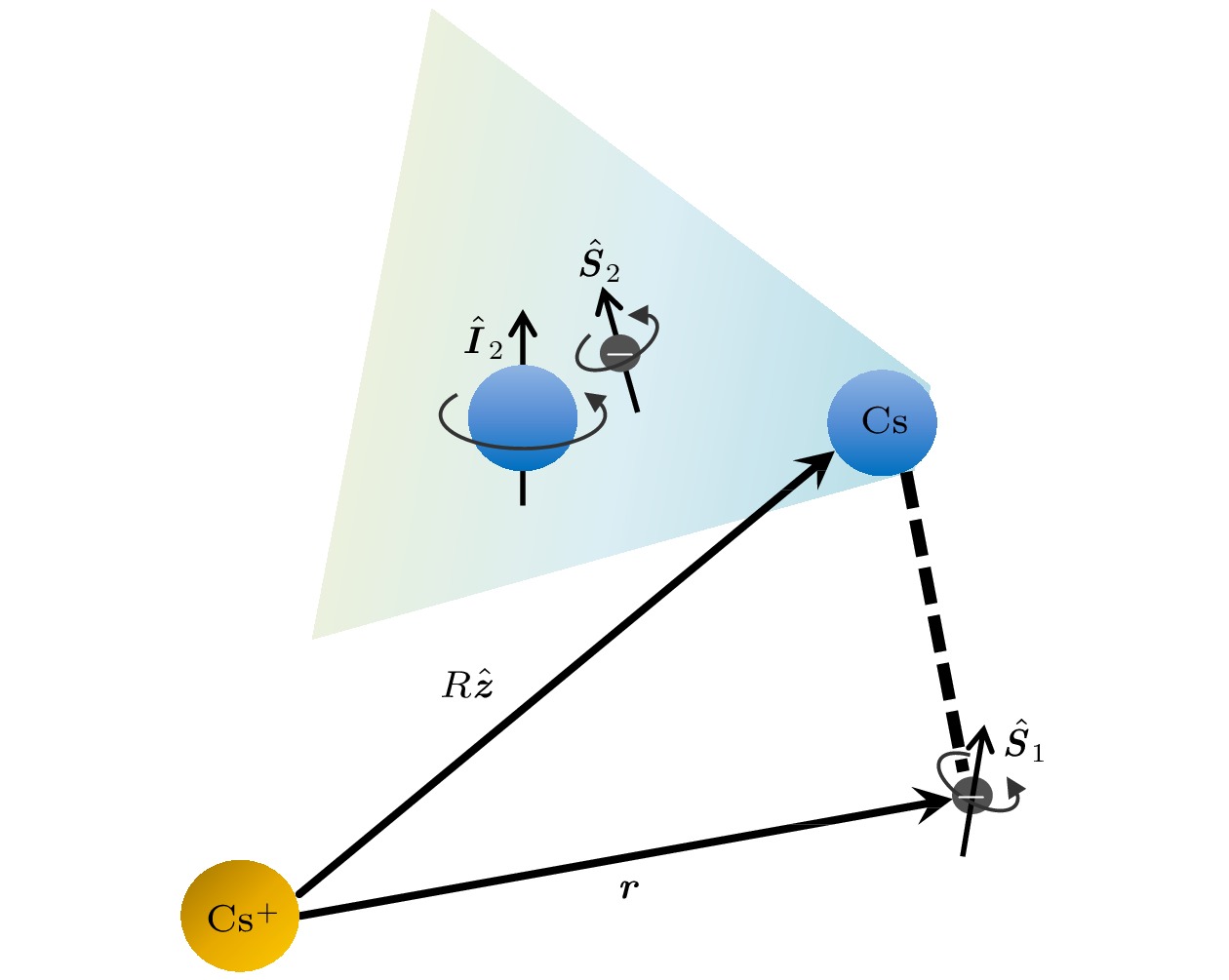
2021, 70 (12): 123201.
doi:10.7498/aps.70.20202229
Abstract +

2021, 70 (12): 128804.
doi:10.7498/aps.70.20201805
Abstract +
With the rapid development of photovoltaic industry in recent years, organic solar cells have attracted much attention due to their advantages of low cost, light weight, capacity of batch production, simple production process and flexible performance. However, there are still some limitations hindering their commercialization process, including low photoelectric conversion efficiency and poor transmission color rendering. The introduction of photonic crystals provides a new way to solve these two problems. Starting from the optimization principle of photonic crystals, the effects of both one-dimensional photonic crystals and two-dimensional photonic crystals on organic solar cells, especially the short circuit current and photoelectric conversion efficiency, are systematically summarized in this paper. Then, we focus on the reasons for the performance improvement of organic solar cells based on one-dimensional photonic crystals and two-dimensional photonic crystals. The results of the experiments and characterization show that the performance improvement is mainly attributed to the photonic crystal acting as the reflector in the device. Photonic bandgap, a vivid property that the photonic crystals have, can block the light transmitting organic solar cells at a certain frequency. So, the light within the photonic bandgap is reflected back into the device, thus promoting the secondary absorption of light by the active layer which can result in the stronger light absorption capacity of the active layer, and then improving the performance of the device. In addition, the reason why one-dimensional photonic crystals can be used to regulate the color rendering of semitransparent organic solar cell is described in detail. This is of great significance to photovoltaic construction industry because semitransparent organic solar cells with excellent color rendering property can be widely used in it. However, due to the limitation of photonic crystal optimization mechanism, the reported applications so far have failed to improve the filling factor and open circuit voltage of the device, and due to the limitation of its own structure, three-dimensional photonic crystals have not been reported to be used in organic solar cells. Finally, by combining the existing research progress of organic optoelectronic devices, we look into the future research direction of organic solar cells based on photonic crystals.
GENERAL
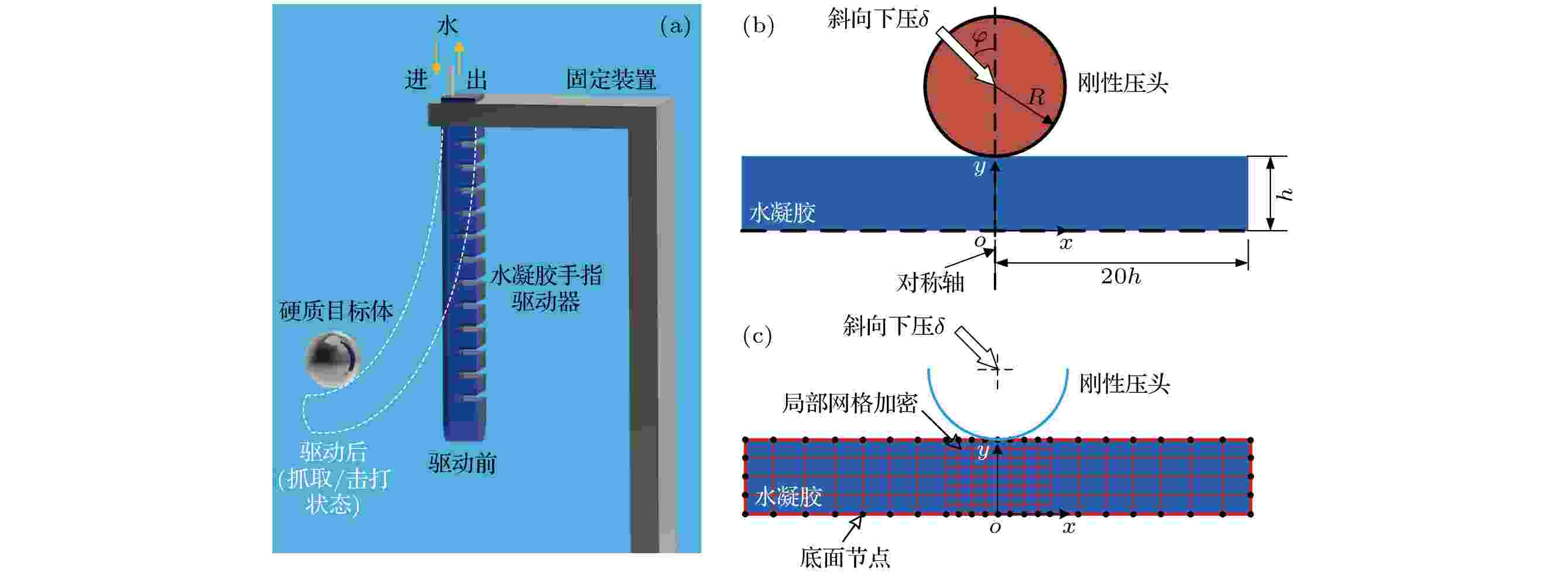
2021, 70 (12): 120201.
doi:10.7498/aps.70.20202134
Abstract +
Focusing on the oblique frictional contact problem of hydrogel for soft robot, a numerical contact model is developed to analyze the nonlinear behaviors including local contact large deformation and friction effect of hydrogel soft material during oblique contact. Based on the constitutive relation of hyperelastic material, the updated free energy function of hydrogel is derived. The contact algorithm is given to compute the contact responses of both collinear contact example and oblique contact example. The applicability of classical Hertz contact theory is discussed. The influence of coefficient of friction on the stress distribution of contact zone and the contact states of contact surface are also investigated. The numerical results show that the material nonlinearity and the geometric nonlinearity (i.e. large deformation) of hydrogel lead to the invalidation of classical Hertz contact theory. For the oblique contact, the internal stress grads of hydrogel will be redistributed as the coefficient of friction increases. Meanwhile, the maximum stress position moves from underside to the contact surface. Two high stress zones occur inside and on the contact surface at the same time, respectively. Besides, when the coefficient of friction is smaller (i.e.μ< 0.05), for the collinear contact all contact points on the contact surface are in critical state from static friction to dynamic friction. But for the oblique contact, some contact points are always in stable static friction state.
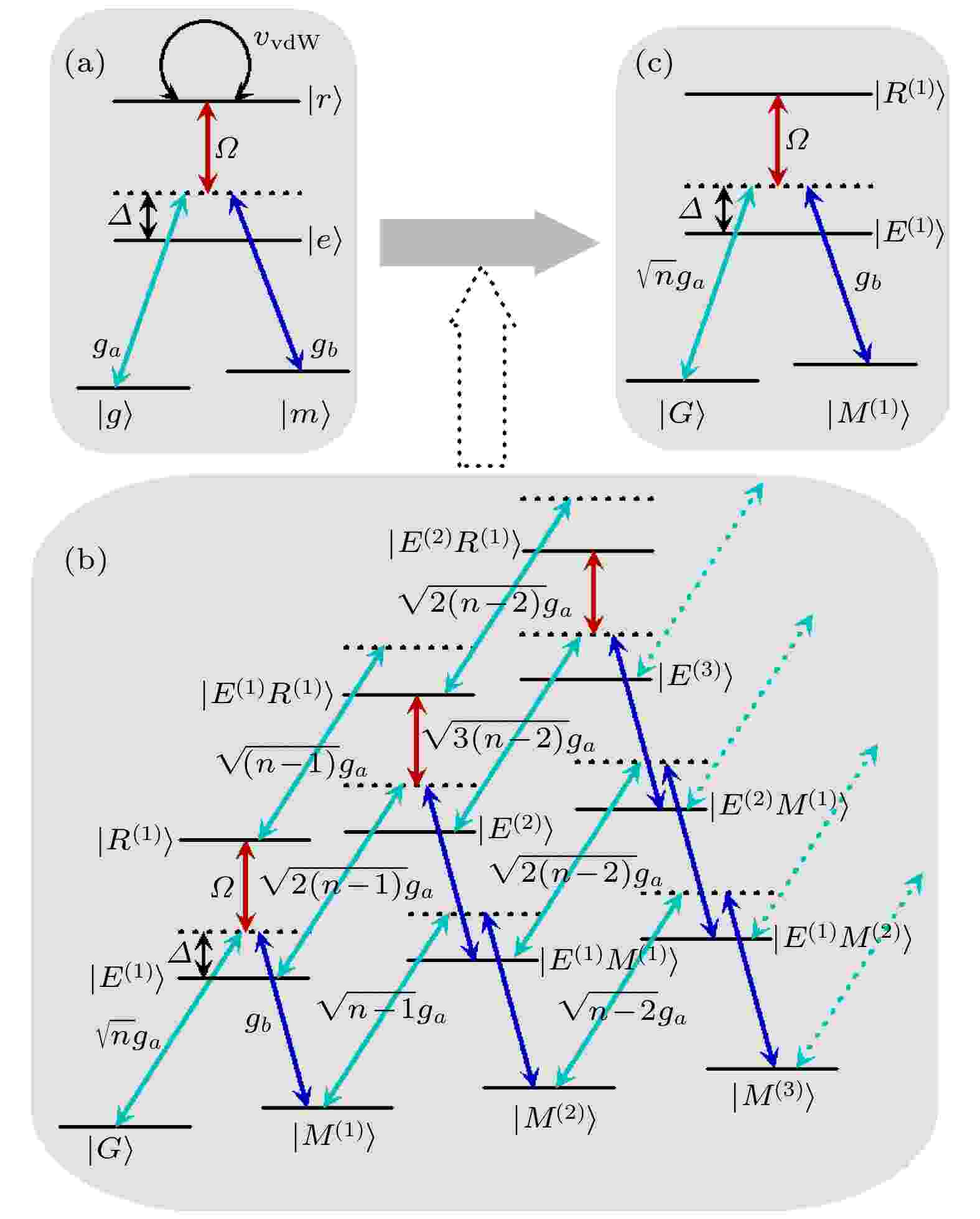
2021, 70 (12): 120301.
doi:10.7498/aps.70.20201841
Abstract +
Quantum entanglement is a basic resource of quantum information processing and quantum computation. The simple and efficient generation of entangled states is always one of the hot research topics. As one of the ideal carriers of quantum information encoding, neutral Rydberg atom occupies a place in the field of generation of entangled state with its unique advantages. For example, Rydberg atom has a large volume and is easily ionized by an external electric field, so it is very sensitive to the change in the external electric field. Therefore, the interaction strength between Rydberg atoms can be changed by altering the external electric field. Rydberg state is a highly excited state, but its radiation attenuation is very small: the radiation lifetime can reach a millisecond level or even longer. The distance between the atomic kernel and the outermost electron is relatively long, and the electric dipole moment is very large. In this paper, the four-level inverted “Y”-type Rydberg atomic system is introduced into the Rydberg blocking ball to form a superatom, and the quantum information is encoded on the effective energy level of the superatom under the condition of weak cavity field. We construct shortcuts to adiabatic passage in a three-superatom system. Combined with quantum Zeno dynamics and shortcuts to adiabatic passage, the three-particle singlet state is simply and effectively generated. In addition, the influence of decoherence factors (including cavity decay and spontaneous emission of superatoms) on the fidelity is considered in this scheme. Numerical simulation results show that the proposed scheme can obtain high fidelity without precisely controlling the evolution time, and the fidelity of singlet state is robust to decoherence factors, since no cavity-photon population is involved in the whole process because of the quantum Zeno dynamics.

2021, 70 (12): 120302.
doi:10.7498/aps.70.20210071
Abstract +
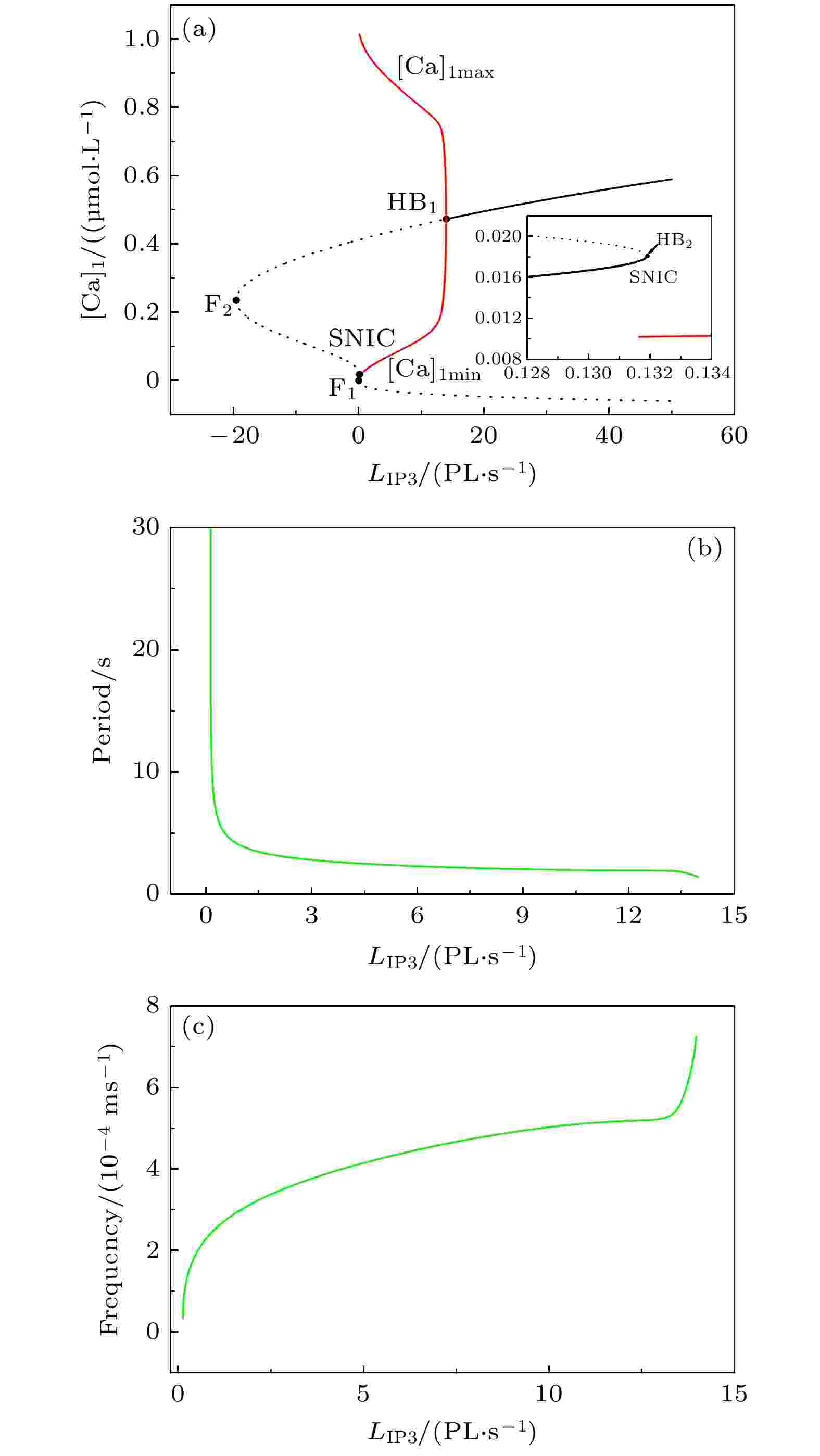
2021, 70 (12): 120501.
doi:10.7498/aps.70.20210093
Abstract +
The pre-Bötzinger complex, which is located at a ventrolateral medulla of human and mammal, is considered to be the center for the generation of respiratory rhythms. In a normal state, the respiratory rhythm is uniform and orderly. Otherwise, the respiratory rhythm will change to a pathological state. Therefore, the monitoring of respiratory rhythm is of great significance in monitoring the health. In this paper, according to a two-coupled model of pre-Bötzinger complex with calcium ion current, we investigate the generation and transition mechanism of anti-phase bursting synchronization by using phase-plane analysis, bifurcation and fast-slow decomposition. It is found that the pre-Bötzinger complex model can exhibit mixed bursting when calcium ion concentration is at steady state, which indicates that the oscillation of calcium is not a necessary condition for the generation of mixed bursting. This is quite different from the results obtained in previous studies, indicating that the mixed bursting is caused by the periodic fluctuations of calcium. The methods used in this paper can provide a new idea for investigating the dynamics of mixed bursting, and it can also be applied to the study of other neuronal systems on a multiple time scale.
NUCLEAR PHYSICS
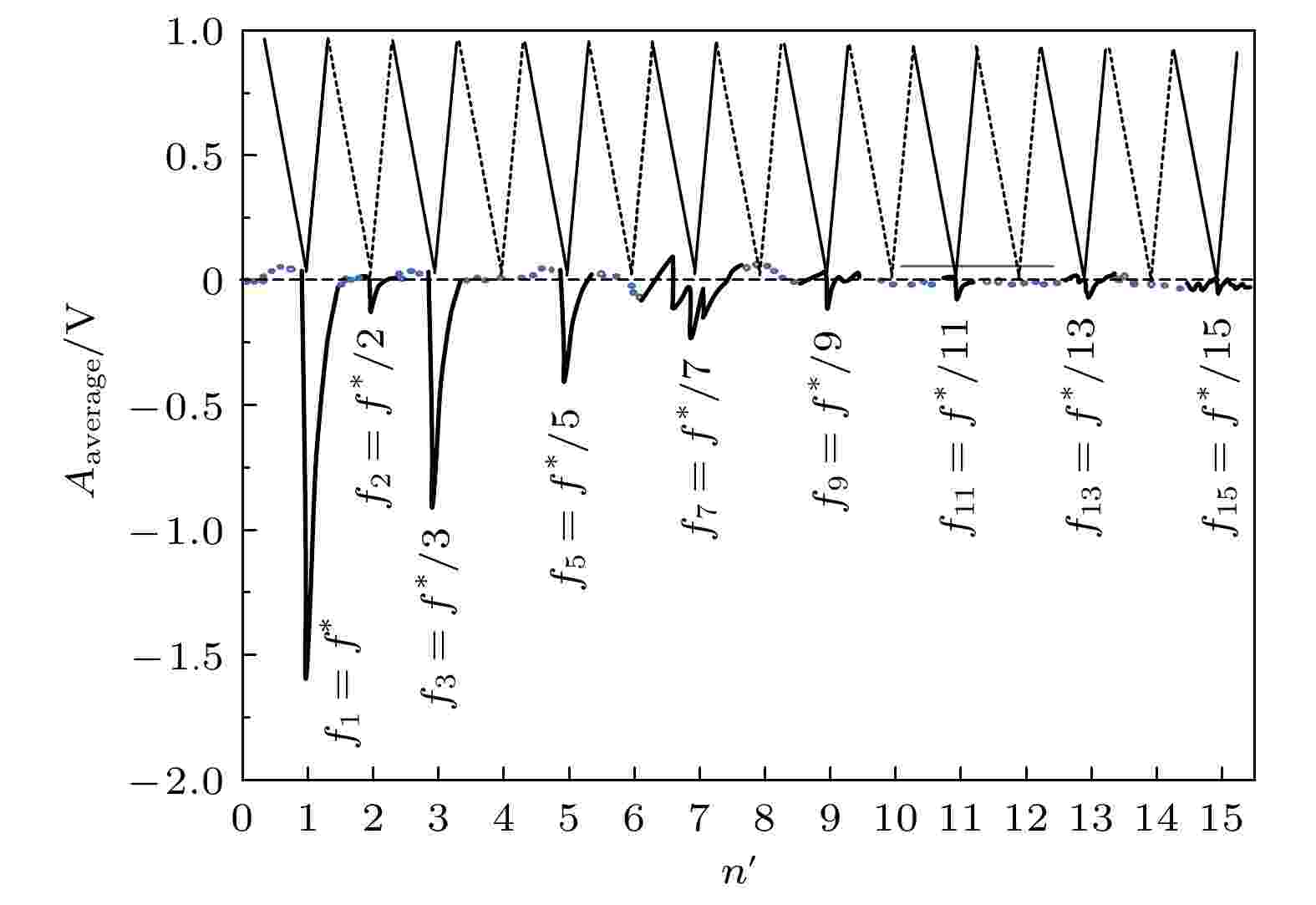
Experimental observation and theoretical analysis of spontaneous magnetic moment of Rb atom clusters
2021, 70 (12): 122101.
doi:10.7498/aps.70.20210031
Abstract +
For the magnetism of alkali metal clusters, it is difficult to determine the number of atoms and the magnetic moment of isolated atoms cluster. In this paper, we investigate the magnetic moment of single atomic molecule87Rb1and 14 kinds of cluster particles (87Rb)
${}_{n'} $
(
$n' $
= 2, 3, 4, ···, 15) in a saturated rubidium vapor sample at about 328 K, by using optical magnetic resonance spectroscopy. The experimental results show that there is a relationshipf
${}_{n'} $
=f*/
$n' $
between the resonant frequenciesf
${}_{n'} $
of 14 kinds of cluster particles (87Rb)
${}_{n'} $
and the resonant frequenciesf* of87Rb1. The magnetic moment and their resonance amplitudes show two different relationships with the
${n'} $
odevity. When the particles have an odd number of 5s electrons, they must have spontaneous magnetic moment, and the value of magnetic moment increases withnand decreases inverse proportionally with the combined angular momentumFof the cluster particles. The amplitude obtained from resonance spectrum complies with the variation law of magnetic moment value. On the other hand, for the cluster particles withnbeing even number, the magnetic moment value becomes 0 and the amplitude is also 0 in the most cases, except for the cluster particles87Rb2withn= 2 i.e. two 5s electrons, which is caused by the Jahn-Teller effect of the linear molecules, and the magnetic moment value is consistent with the calculation results of the odd number particles. Whenn> 2, the coupling effect between the magnetic moments of the Rb cluster shows a long-range ordered antiferromagnetic property with the increase of the number of 5s valence electronsn. The electron configuration and molecular state of the ground state and the lowest excited state of 14 kinds of 2—15 atoms cluster particles87Rbn, as well as the stability of each molecular state and the possibility of visible Zeeman effect are obtained by using the molecular orbital-state theory analysis and constructing the87Rbn–1+87Rbnatomic cluster model. Furthermore, based on the magnetic moment of diatomic molecules ruler, it is found that whenn=
${n'} $
, the magnetic moment of (87Rb)
${}_{n'} $
and87Rbnare in strict consistency (the average relative error is only 0.6765%), confirming the corresponding relationship between (87Rb)
${}_{n'} $
and87Rbn. This research will be of great value in the magnetic research of cluster particles.

2021, 70 (12): 122801.
doi:10.7498/aps.70.20202239
Abstract +
Since thorium (Th) owns high conversion ratio in thermal neutron spectrum, high melting temperature, high thermal conductivity and good corrosion resistance in high-temperature water, it can be doped into UO2based fuel to initiate the fission reaction, and improve the physical properties of UO2. Owing to the challenging experimental conditions and technologies, molecular dynamics (MD) simulations are conducted to investigate the influences of Th doping on the mechanical properties of U1–xThxO2. The phase transition from initial fluorite structure to the metastable scrutinyite phase when loading along the [001] direction is observed, which accords well with the previous density functional theory calculations. However, if U1–xThxO2is loaded along the [111] direction, only brittle fracture is observed. It is found that both the elastic modulus and fracture stress decrease linearly with elevating temperature but the fracture strain increases. As the Th concentration increases from 0 to 0.55, the elastic modulus first decreases and then increases; if the Th concentration is larger than 0.1, the fracture stress increases and the fracture strain decreases monotonically. The cracks are nucleated with an angle of 45º to the loading direction, propagate rapidly, and are characteristic of brittle fracture, which accords well with the classical failure criteria and experimental results for brittle materials. By comparison, the uniaxial tensile loading is also performed for polycrystalline U1–xThxO2. It is found that the elastic modulus and fracture stress decrease as the temperature increases. However, the elastic modulus is not sensitive to the Th concentration and the fracture increases as the Th concentration increases. The brittle intergranular fracture is observed in each of all polycrystalline samples. The obtained physical parameters are useful for designing the fuels in nuclear reactors.
ATOMIC AND MOLECULAR PHYSICS
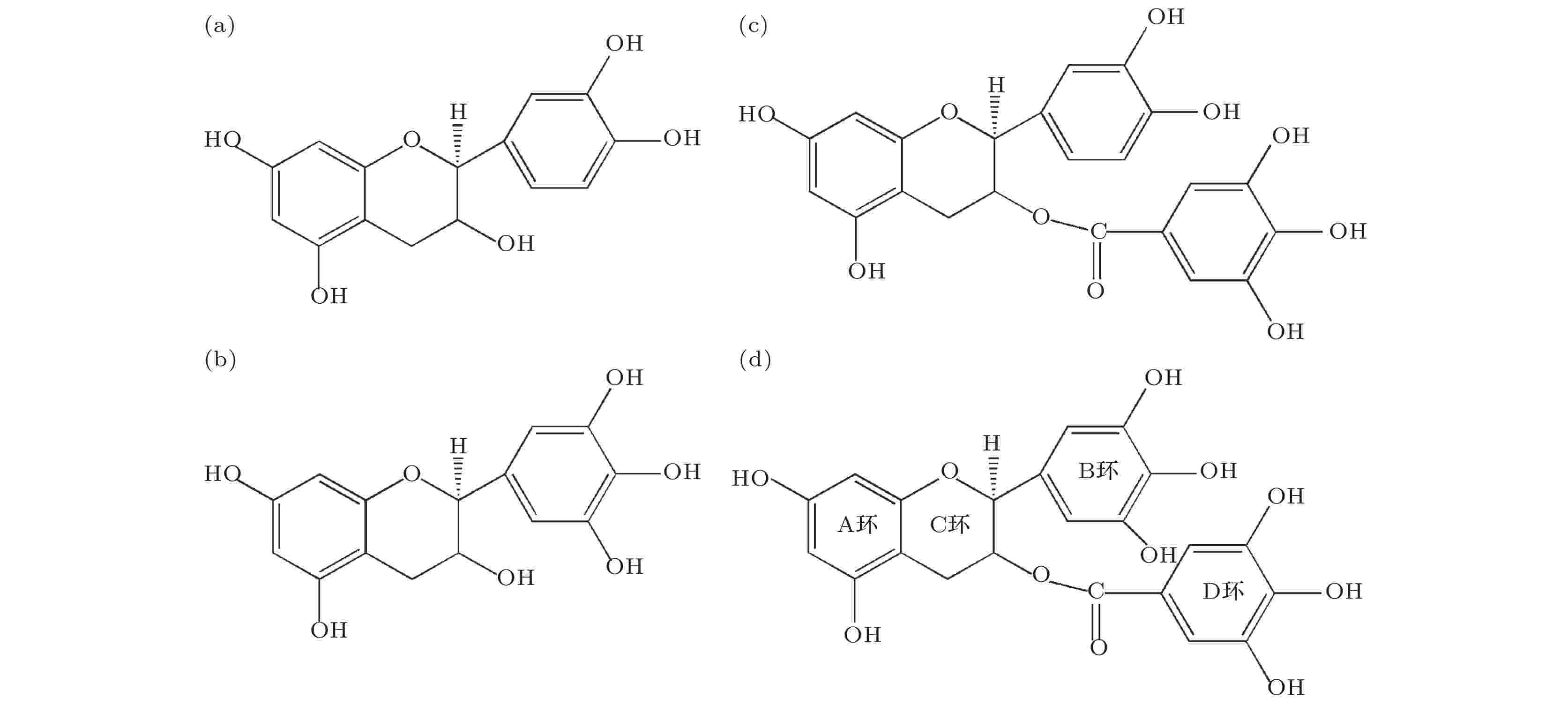
2021, 70 (12): 123101.
doi:10.7498/aps.70.20201947
Abstract +
Persimmon tannin has excellent adsorption efficiency of heavy metal ions, and epigallocatechin gallate (EGCG) is the key structural monomer of persimmon tannin to play its active role. In order to analyze the nature of the interaction between persimmon tannin and metal ions, in this paper the density functional theory (DFT) is used to calculate and analyze the interactions between EGCG and metal ions (Ag+, Hg2+, Cu2+, Fe2+, In3+, Al3+, Au3+), from the respects of EGCG-metal complex configuration, Mayer bond order, natural population analysis, binding energy, and weak interaction. In this paper, the B3LYP combined with DFT-D3 dispersion correction method is mainly used. For metal atoms, the Lanl2dz basis set is adopted. For H, C and O atoms, the 6-311G (d, p) basis set is adopted for optimizing the structure, and the more accurate 6-311+G (d, p) basis set is selected for calculating the single point energy. At the same time, the study adds the SMD solvation model with water as the solvent. All calculations are done by using the Gaussian 09 package. The method of reduced density gradient function is used to study the weak interactions between EGCG and metal ions. The results of research show that EGCG-Fe2+complex is adsorbed mainly by chelating bond. However, the EGCG adsorbs mainly Ag+, Hg2+ions through electrostatic attraction. The configurations of the complexes show that In3+, Al3+and Au3+ions with EGCG form unique “luminal structure” metal complexes, so there is not only electrostatic attraction, but also aromatic ring stacking between these three metal ions and D ring 4"O, 5"O. The calculated Mayer bond order indicates that the bond order of the composite bond is formed by Fe2+ion and the EGCG is the largest in the seven metal complexes, and the bond order is formed by In3+ion, and EGCG is smallest. The compound of Cu2+ion and EGCG have chelation, electrostatic attraction and aromatic ring stacking. By observing the binding energy, it can be found that the more charges the metal ions have, the easier the charge transfer will be and the stronger the electrostatic attraction of EGCG may be. These results will provide enlightenment for further studying the mechanism of persimmon tannin's adsorption of metal ions.
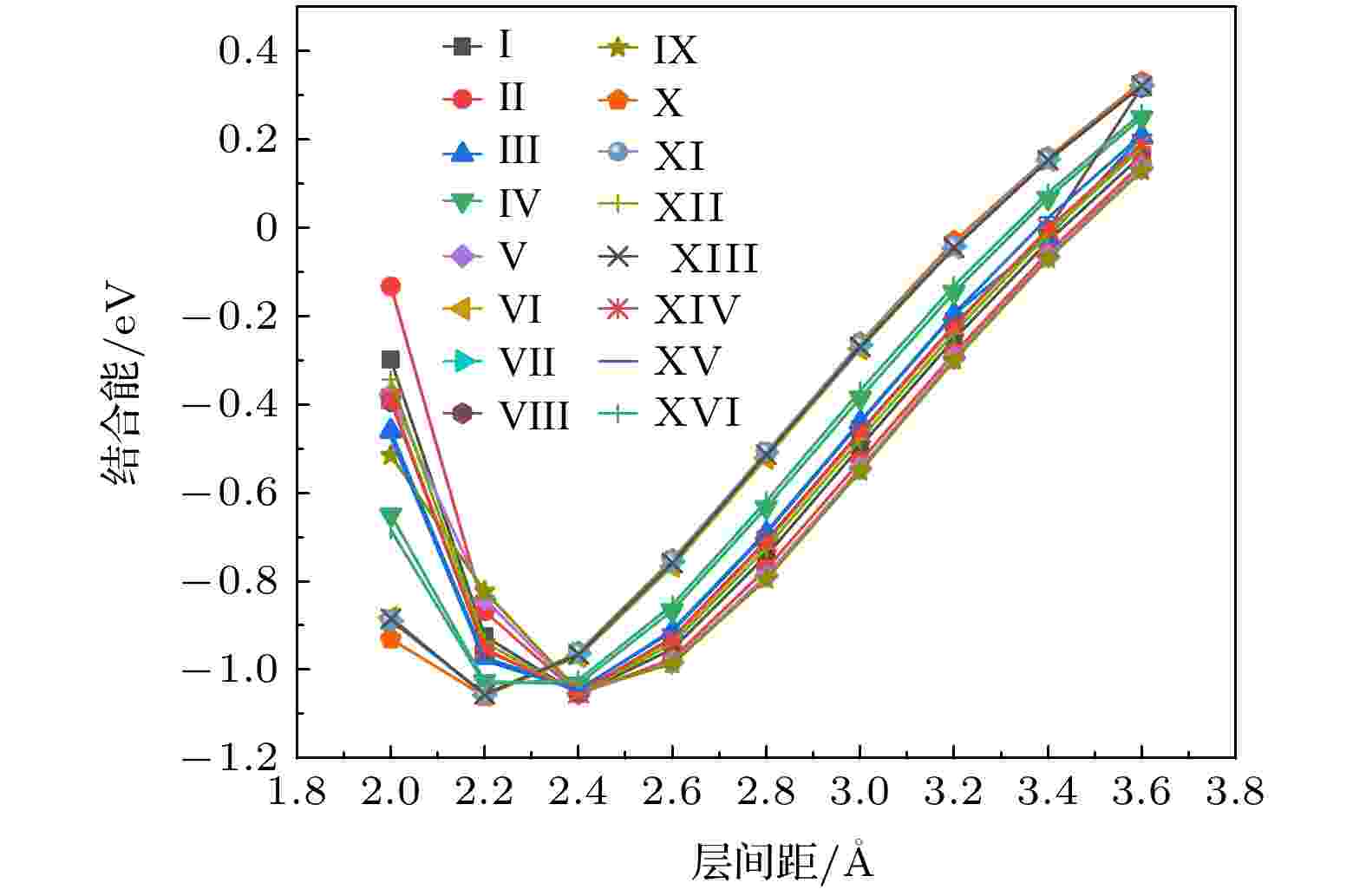
2021, 70 (12): 123102.
doi:10.7498/aps.70.20202193
Abstract +
Since the discovery and synthesis of graphene, two-dimensional graphether and silicether materials have been predicted as novel semiconductors. A novel two-dimensional silicether/graphether heterostructure is designed by combining silicether and graphether, which has unique optical and electronic properties due to the properties of a single material synthesized by heterostructures. The electronic and optical properties of silicether/graphether heterostructure are studied by the first-principles calculations based on density functional theory. The binding energy and layer spacing for each of all considered 16 stacking patterns of the heterostructures are calculated. The results show that different stacking patterns have a small effect on the binding energy of the heterostructure. When the layer spacing is 2.21 Å, the stacking pattern in which the concave oxygen atoms of graphether are on the top of the concave oxygen atoms of silicether is the most stable. In addition, it has an indirect band gap of 0.63 eV, which is smaller than that of the silicether and graphether, respectively. By changing the external electric field and the biaxial strain strength, the band gap of the silicether/graphether heterostructure shows tunability. The compressive strain can increase the band gap of silicether/graphether heterostructure, while the band gap decreases with the tensile strain increasing. Especially, when the compressive strain is greater than –6%, the heterostructure undergoes an indirect-to-direct band gap transition, which is beneficial to its applications in optical devices. When the external electric field is applied, the band gap of the heterostructure changes linearly with the strength of the electric field, and the indirect band gap characteristic is maintained. The absorption coefficient of silicether/graphether heterostructure shows a strong peak in the ultraviolet light region. The maximum absorption coefficient can reach up to 1.7 × 105cm–1around 110 nm. Compared with that of monolayer graphether and silicether, the optical absorption of the heterostructure is significantly enhanced within the range from more than 80 nm to less than 170 nm. The results show that silicether/graphether heterostructure has an outstanding optical absorption in the ultraviolet region. Moreover, the silicether/graphether heterostructure also shows considerable absorption coefficient (1 × 104—4 × 104cm–1) in the visible region, which makes it a potential material in photovoltaic applications. This work may provide a novel material with a promising prospect of potential applications in nanodevices.
ELECTROMAGNETISM, OPTICS, ACOUSTICS, HEAT TRANSFER, CLASSICAL MECHANICS, AND FLUID DYNAMICS
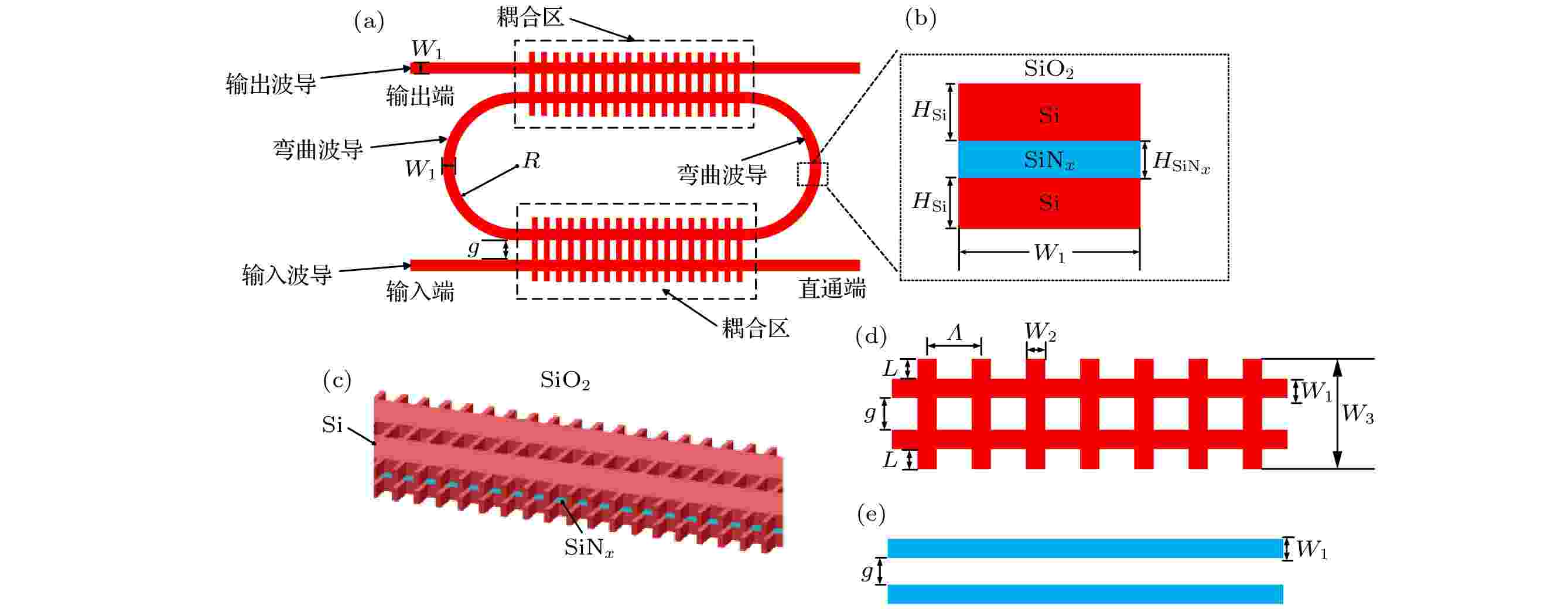
2021, 70 (12): 124201.
doi:10.7498/aps.70.20201965
Abstract +
Ring resonator fabricated on a silicon-on-insulator is versatile in optical integration, which can be used to realize filters, modulators and switches. However, silicon-on-insulator is difficult to control the polarization dependence, and thus its application is greatly limited. The polarization dependence of the ring resonator is caused mainly by two factors: the coupling coefficients of the coupling region at the same wavelength for the two orthogonal polarization modes are different, and the birefringence effect of curved waveguide results in the different resonant wavelengths of TE and TM polarization modes. When the coupling region polarization independence and the resonant wavelength polarization independence are simultaneously satisfied, the polarization independence of the ring resonator can be realized. In this paper, a new type of polarization-insensitive ring resonator on a silicon-on-insulator is designed based on subwavelength grating and sandwiched structure. Firstly, by adjusting the duty cycle of the subwavelength grating and the refractive index of SiNxin the coupling region, polarization independence of the coupling region is achieved. Secondly, the refractive index of SiNxin curved waveguides is designed to make the resonance wavelengths for orthogonal polarization modes equal. Thirdly, the parameters of the coupling region are optimized to reduce the insertion loss. The three-dimensional finite-difference time-domain method is used for simulation. The results show that the radius of the ring is only 10 μm, the 3-dB bandwidth of the device is less than 0.8 nm, and the insertion loss is lower than 0.8 dB. It has potential applications in the future dense wavelength division multiplexing systems.
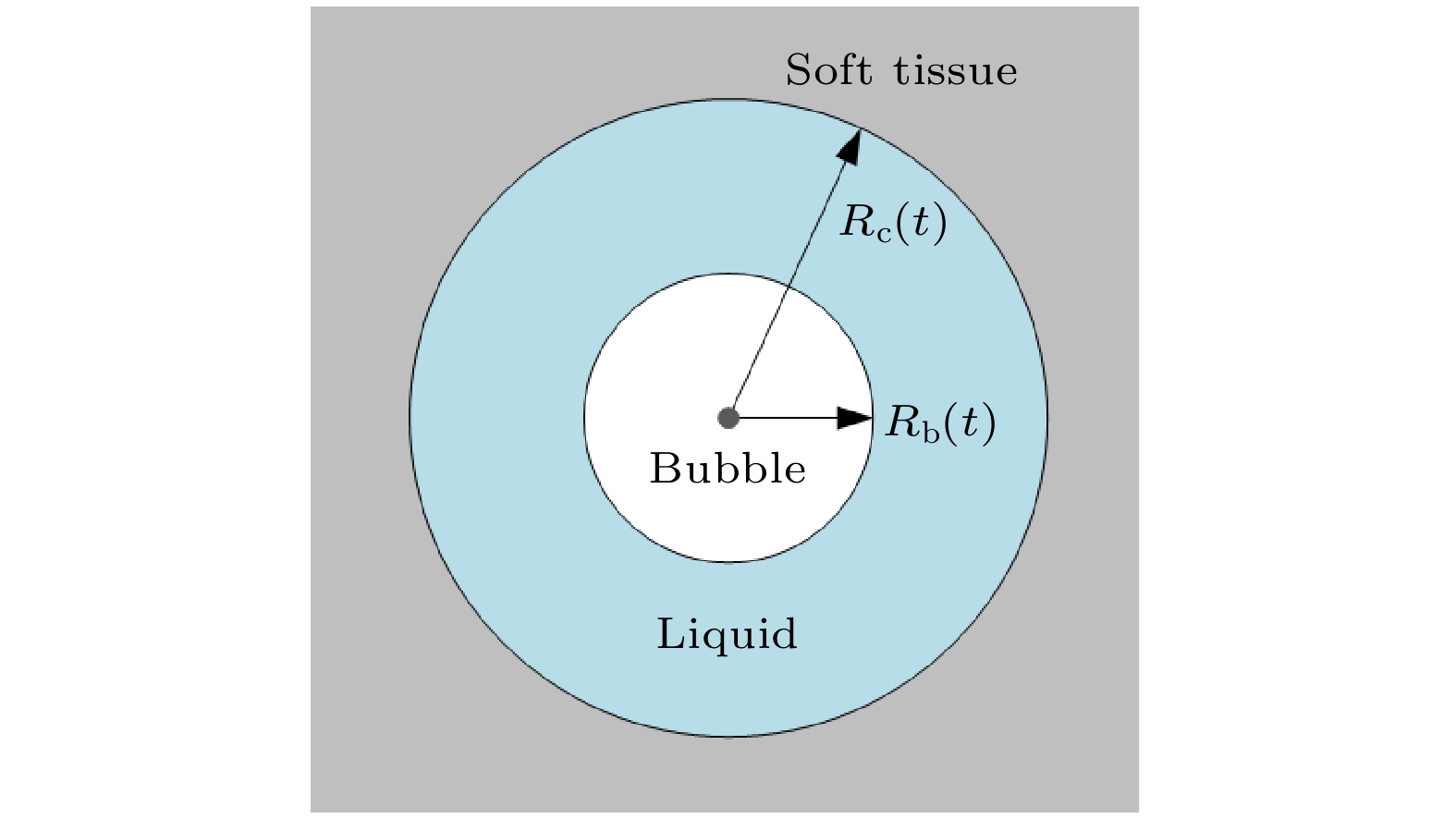
2021, 70 (12): 124301.
doi:10.7498/aps.70.20201876
Abstract +
Ultrasonic wave with higher intensity will directly cavitate in soft tissue. It is an important issue in ultrasonic therapy that the cavitation bubbles in soft tissues are driven in the ultrasonic field. It is assumed that the medium inside the bubble is gas, the cavity is filled with the incompressible viscous liquid, and the medium surrounding the cavity is viscoelastic solid. To introduce the effect of the surrounding tissue, it is assumed that the tissue is incompressible, linear and Voigt viscoelastic solid. The motion of a cavitation bubble can be affected by many factors, such as acoustic pressure, acoustic frequency, tissue elasticity and cavity size. Numerical simulation shows that the resonance frequency and amplitude of the bubbles decrease with cavity radius decreasing. It is also shown that the amplitude of the radial motion for bubbles decreases with the increase of the tissue shear modulus and the frequency, when the ratio of bubble radius to the cavity radius is constant. The effect of the elasticity is very obvious, which reduces the amplitude greatly. The effect of elasticity will be less when the driving pressure is strong. It is found that the inertial cavitation threshold of bubble is relatively low in a range of 1–5 μm. The inertial cavitation threshold of bubble increases with the increase of shear modulus and driving frequency. The smaller the cavity radius, the higher the inertial cavitation threshold of the bubble is. This report aims to provide a firm theoretical basis for the future study of bubbles in a liquid-filled cavity surrounded by a viscoelasticity tissue.
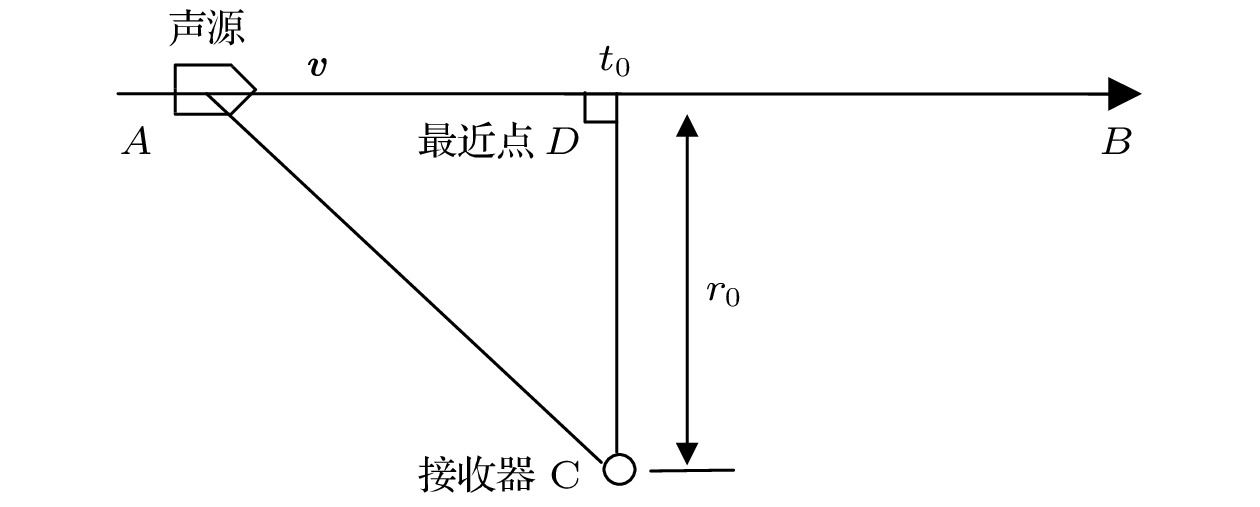
2021, 70 (12): 124302.
doi:10.7498/aps.70.20201653
Abstract +
When there appears the relative motion between the sound source and the receiver, the received tonal signal will produce Doppler shift, and the Doppler information is relevant to the motion parameters of the target. According to the acoustic Doppler shift frequency, we propose the Doppler-warping transformation. The phase linearization of the Doppler signal can be realized by using the transformation. Then, we deduce the warping operator and propose an algorithm for estimating the target motion parameters by using the proposed transformation. Firstly, the Doppler-warping operator under different motion parameters is constructed. Secondly, the time resampling of the received time-domain signal is performed by using the operator. Then, the spectral function of the transformed signal is calculated. Finally, the spectral function entropy is minimized to estimate the objective parameter. The simulation results show the effectiveness of the proposed method. For a low signal-to-noise ratio of sea trial data, where the real speed of a fishing boat is 4.5 m/s, the result from the traditional minimum mean square error (MMSE) velocity estimation method is 5.2 m/s, and the estimation error is 15.56%. The proposed Doppler-warping transform method can estimate the target velocity more accurately, specifically, it is 4.7 m/s and its corresponding estimation error is 4.44%.
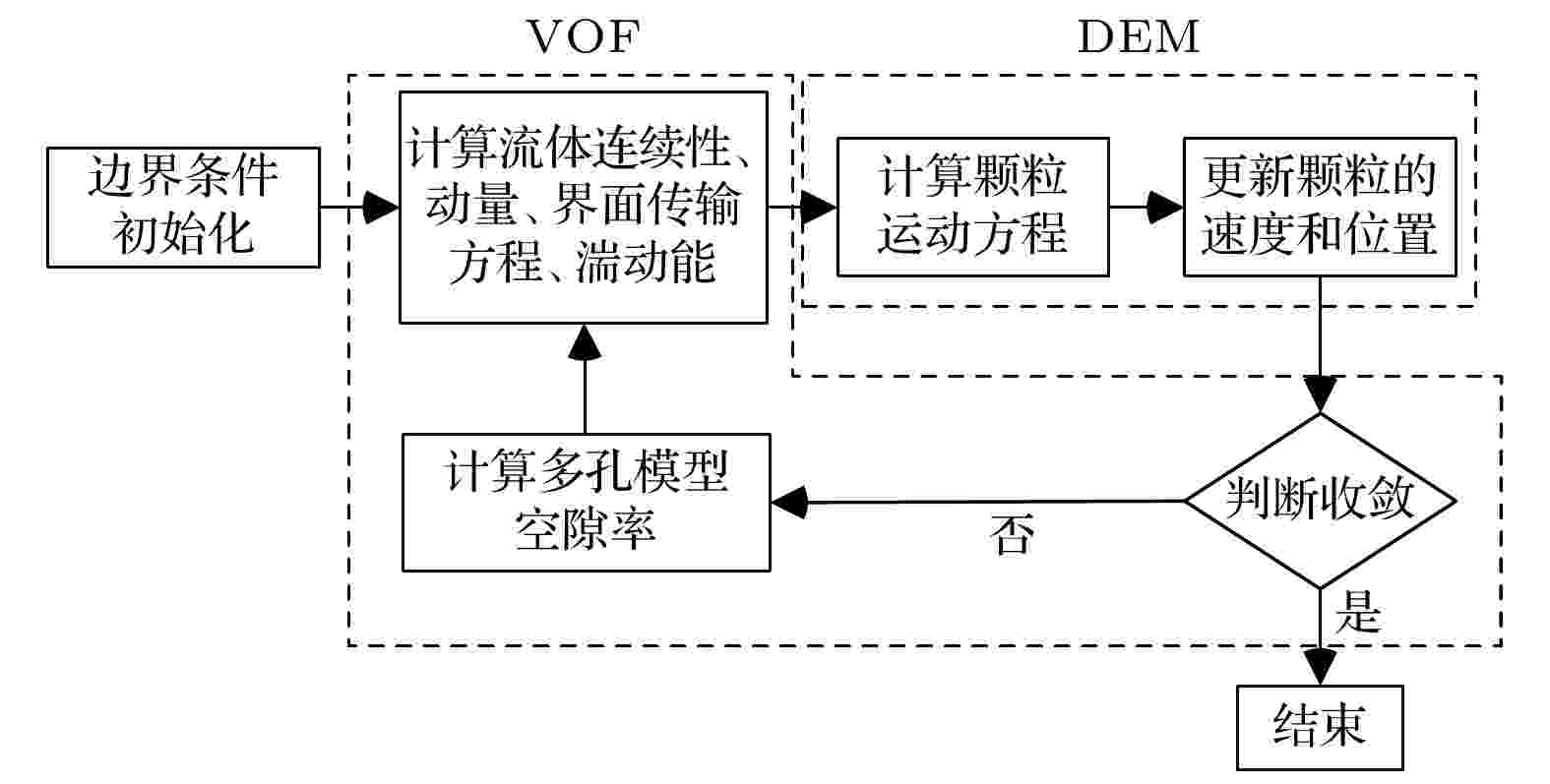
2021, 70 (12): 124501.
doi:10.7498/aps.70.20202126
Abstract +
The mixing process of gas-liquid-solid three-phase flow is a complex multi-fluid-structure coupling dynamic problem. The relationship between the particle parameters and the physical spatial scale of the flow channel directly affects the calculation convergence. Numerical modeling and mesh processing of fluid-structure bidirectional interaction in the strong shear zone are difficult. Aiming at the above problems, a method of modeling and solving the gas-liquid-solid three-phase flow mixing is proposed. Based on the volume-of-fluid coupled with discrete-element-method model, a three-phase dynamic model considering particle motion is established. By solving the momentum equation, the bidirectional coupling of two-phase fluid and particle is realized. The user-defined function communication interface is developed independently to obtain the interaction force between fluid and particles, and a porous-interphase coupling solution is proposed to describe the trajectory of particles. Taking the mixing process of three-phase flow with strong shear for example, this method is used to study the influence of different aeration conditions on the free surface, velocity distribution and particle suspension characteristics in the physical space of the flow channel. The results show that strong shear and wall action can convert the tangential velocity of the fluid into axial and radial velocity; choosing an appropriate inflation velocity can eliminate the instability of the free surface and increasing the flow velocity of the fluid has a limited effect on the suspension of particles in some areas. The research results can provide a useful reference for studying the interaction mechanism of complex multiphase flow, and also provide technical support for the mixing production control of gas-liquid-solid three-phase particles.
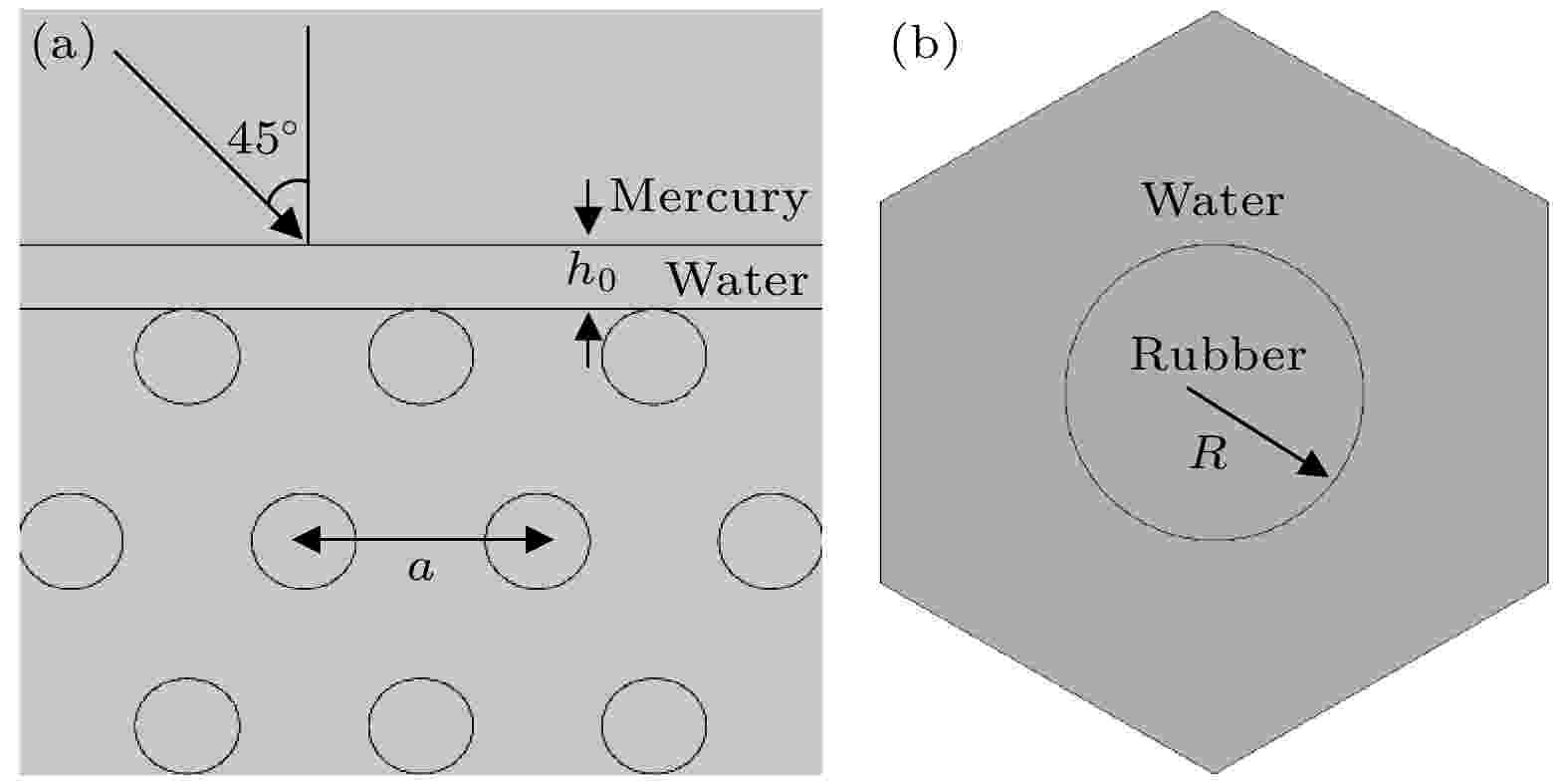
EDITOR'S SUGGESTION
2021, 70 (12): 124601.
doi:10.7498/aps.70.20202108
Abstract +
In this paper, the Schoch displacement at the interface between different two-dimensional triangular phononic crystal metamaterial and natural material is studied by using finite element software. As is well known, the Schoch displacement is highly dependent on the surface wave and leakage wave excited at the interface between different materials. So, the negative Schoch displacement can be more easily obtained by adding a suitable thickness of covering layer at the interface between metamaterial material and natural material. The numerical results show that when the negative Schoch displacement happens, the effective parameters of metamaterials are close to zero. It means that the effective refraction index is near to zero and the reduced frequency of the incident acoustic wave is correlated with the reduced frequency of the band gap. It is also found from the results that the reduced frequency of the incident acoustic wave is located at the edge of the band gap when the negative Schoch displacement occurs. The maximum of the metamaterial effective impedance and the maximum of the reflection coefficient are almost at the same frequency. The phase of the imaginary part of the reflection coefficient has a phase mutation in π rad at the corresponding frequency. The frequency of negative Schoch displacement is located in the first band gap ofMKdirection and near the upper boundary. The Schoch displacement at the interface between conventional materials is usually positive and negligible in previous reports. In this paper, the negative Schoch displacement is obtained by using the near-zero refraction index metamaterials. This not only enriches the physics contents of Schoch effect but also provides a theoretical reference for designing the acoustic devices based on acoustic wave displacement at the interface.
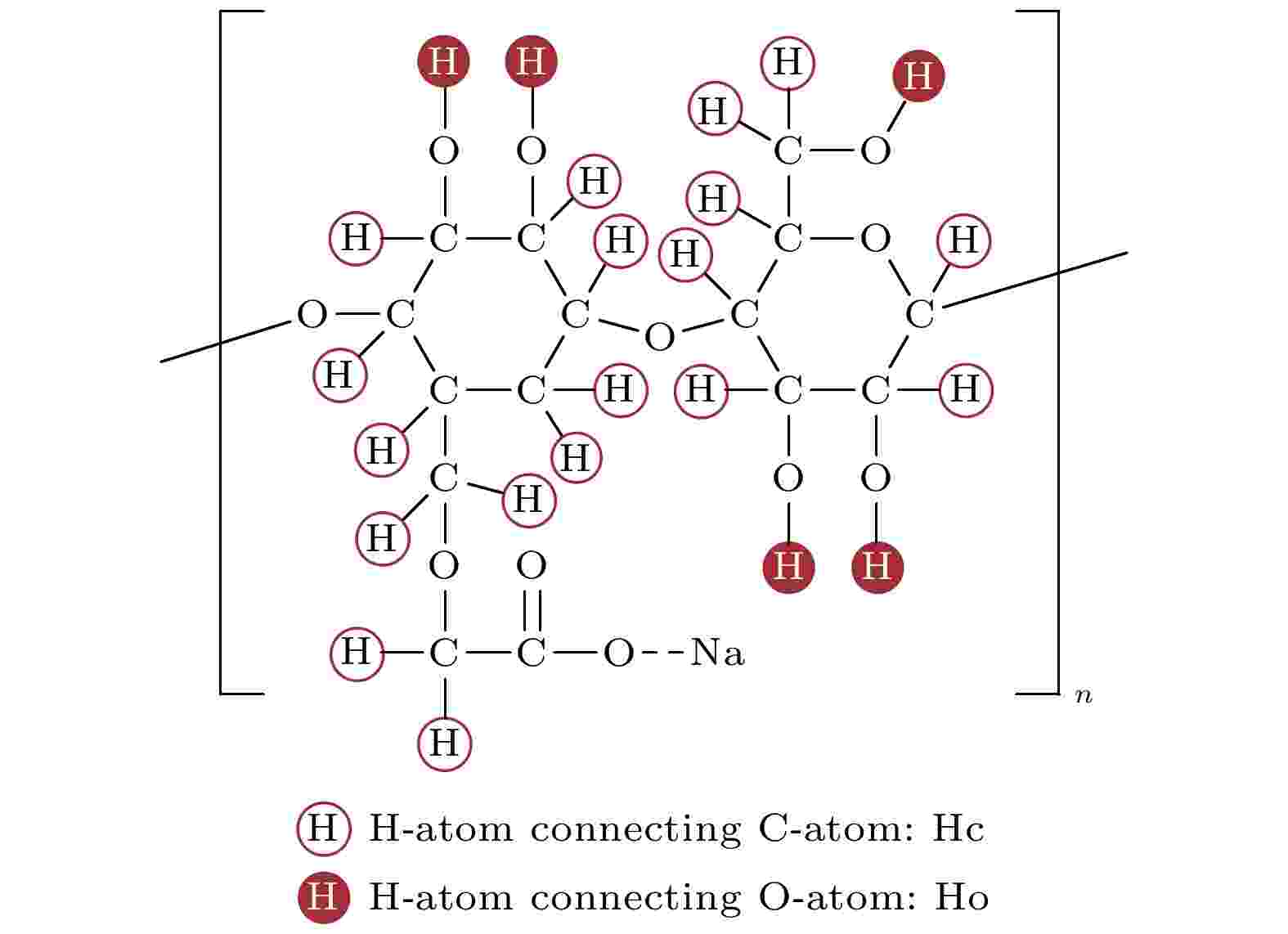
2021, 70 (12): 124701.
doi:10.7498/aps.70.20202116
Abstract +
Non-Newtonian fluids are widely used in microfluidic systems and biomedical fields. In this paper, based on molecular dynamics simulation, taking the system composed of sodium carboxymethyl cellulose molecules and water molecules as the research object, the configuration evolutions of sodium carboxymethyl cellulose solution are simulated under different shear rates. Change of the solution viscosity is characterized by mean square displacement of sodium carboxymethyl cellulose molecules and the relative velocity between water layer and shear boundary. The effect of hydrogen bonding on the viscosity of the solution is analyzed emphatically. The results show that water molecules and solute molecules attract each other to form a more compact hydrogen bond network, which increases the viscosity of the solution; the peak value of the radial distribution function between the hydrogen atoms attached to carbon and the water oxygen atoms decreases when shear action is applied to the solution, and the hydrogen bond between the two atoms is weakened; the mobility of solute molecules increases and the blocking effect of water molecules on the movement of solute molecules weakens under the shear action; at the same time, the shorter the distance to the shear boundary, the closer to the shear velocity the velocity of water molecules is, and with the increase of distance, the velocity of water molecular layer decreases greatly. These results are macroscopically understood as the viscosity of the system decreasing. As the shear rate increases, the shear thinning of the sodium carboxymethyl cellulose solution becomes more significant.
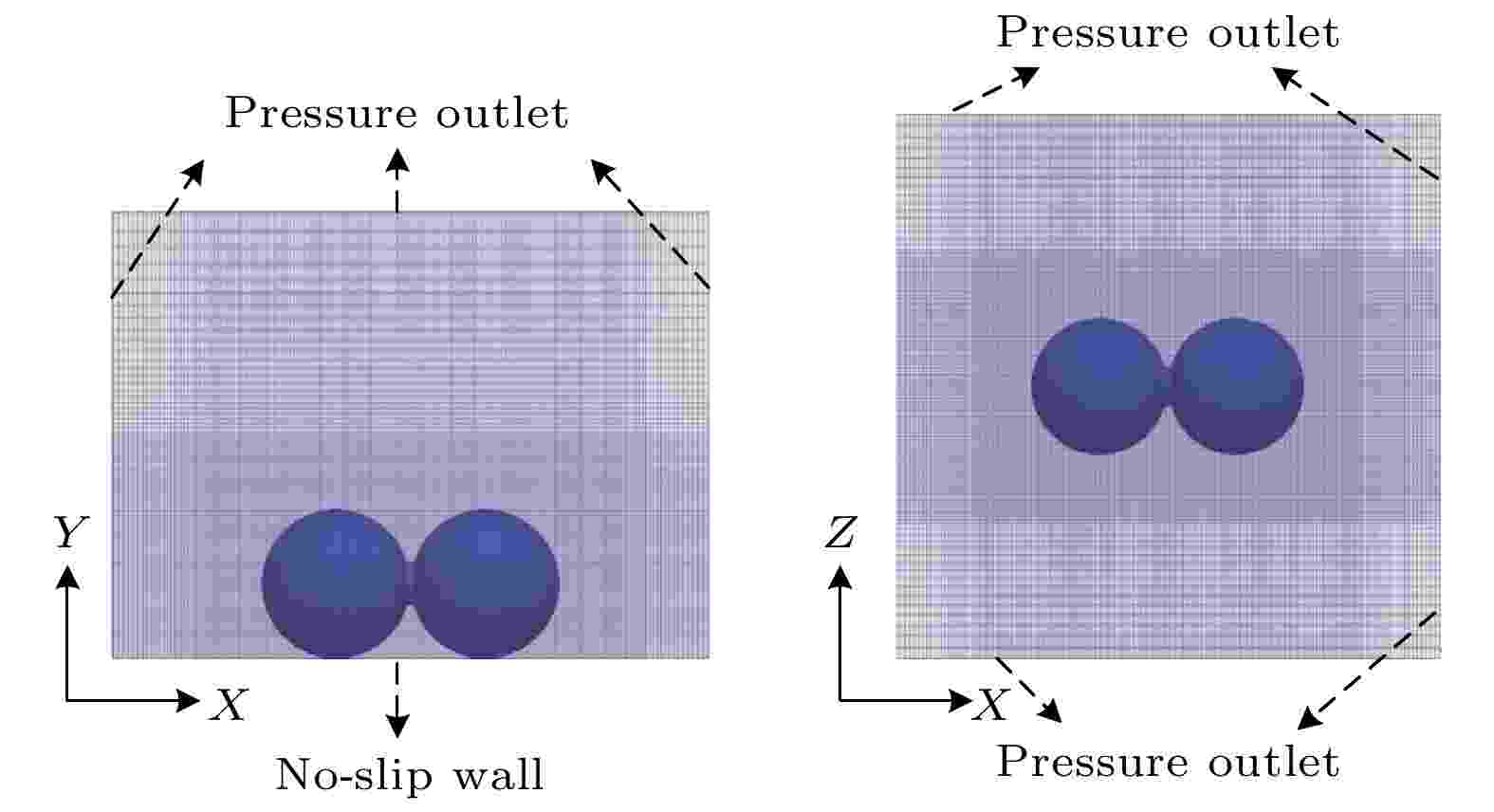
EDITOR'S SUGGESTION
2021, 70 (12): 124702.
doi:10.7498/aps.70.20201714
Abstract +
Coalescence-induced self-propelled jumping of droplets on superhydrophobic surfaces has been widely concerned because of a great number of potential applications such as in the enhancement of condensation heat transfer, self-cleaning and anti-icing. The droplet jumping phenomenon exists in a gas-liquid two-phase system, and the physical parameters of fluid cannot be ignored. However, there are few reports on the influence of physical parameters on droplet jumping dynamics at present. In this paper, the three-dimensional volume-of-fluid method is used to simulate the coalescence-induced self-propelled jumping behaviors of droplets, then the energy terms are studied, and finally the grey relational analysis method is used to calculate the relation degree of the change of physical parameters (the viscosity and the density) to the real jumping velocity and the real solid-liquid contact time at the droplet departure time, respectively. Based on the changing trend of jumping velocity, the process of coalescence-induced self-propelled jumping can be divided into four stages, namely, the expansion of liquid bridge, the impact between the liquid bridge and the surface, the droplet departure from the surface, and the deceleration and oscillation in the air. Under the condition of dimensionless time, the dynamic characteristics of coalescence and jumping of droplets are affected only byOhnumber, which is independent of the viscosity and the density. In addition, the change ofOhnumber only affects the above third stage of droplet departure from the surface. Under the condition of real time, the varied viscosity has no connection with the real time of droplet coalescence, and it only changes the real time of the third stage before droplet jumping. Meanwhile, the dimensionless jumping velocity decreases withOhnumber increasing, while the real jumping velocity increases when the viscosity and the density both descend. According to the calculated results of grey relational degree, the relation between the change of viscosity and the real jumping velocity is greater, while the relation between the change of density and the real contact time is greater. This work not only is favorable for a better understanding of droplet jumping, but also provides more ideas and theoretical bases for follow-up relevant studies.
CONDENSED MATTER: STRUCTURAL, MECHANICAL, AND THERMAL PROPERTIES

2021, 70 (12): 126101.
doi:10.7498/aps.70.20201584
Abstract +
The wetting modes of droplet on nanostructure surface including Cassie, Partial Wenzel, and Wenzel are of great importance in enhancing the condensation heat transfer, surface self-cleaning and oil-water separation. Previous studies focused mainly on the behaviors of droplets on the surface of nano-pillar structures. In this work, the wetting behaviors of argon nanodroplet on platinum surface is investigated by the molecular dynamics simulations. The effects of nanostructure geometry parameters and characteristic contact angleθeon the wetting mode and the transition between different modes are investigated. The three-dimensional simulation box includes a bottom wall containing trapezoid wires (TWs) with different geometry parameters and other five surfaces. The TWs are populated on the wall based on the array arrangement. The periodic boundary conditions are imposed on the four side surfaces of the simulation box. The base angles of the side surface of TW with respect to horizontal plane are chosen as 60° (inverted TW), 90° (rectangular pin fin) and 120° (TW), respectively. For all the three base angles, the nanostructure surface can be completely wetted by liquid, behaving as the Wenzel mode whenθe< 118°, under which the gaps of nanostructures are filled with liquid. However, when the characteristic contact angleθeis in a range of 118°–145°, the base angles of nanostructures have different effects on wetting modes. The surface with inverted TWs (60° base angle) is conducive to keeping droplet in Cassie mode, in which the liquid does not penetrate into any gap of nanostructures. The surface with rectangular pin fins behaves as either Partial Wenzel mode or Cassie mode. The transition between the two modes takes place atθe~130°. The surface with TWs (120° base angle) keeps the droplet in Partial Wenzel mode, in which the gaps of nanostructures are partially wetted by liquid. Forθelarger than 145°, the dewetting process takes place on the surface of the nanostructure, in which the droplet leaves the solid surface. We conclude that the wetting modes on nanostructured surface satisfy the minimum surface energy principle. Our work discloses a new finding that the surface with inverted TWs is easy to maintain Cassie mode, which is good for dropwise condensation applications.

2021, 70 (12): 126102.
doi:10.7498/aps.70.20210192
Abstract +
Ions with the same linear energy transfer (LET) value, but different energies and species have various ion track characteristics, and thus induce different single event transient (SET) responses in combinational logics. As the technology feature size shrinks, this issue continues to be serious. The research of the relationship between ion track characteristics and SETs in the nanometer combinational logic circuits is of great significance for accurately predicting the soft error rates of nanometer devices used in spacecraft. The combinational logic circuit investigated in this paper is a 65 nm bulk silicon complementary metal oxide semiconductor (CMOS) technology inverter chain. The three-dimensional TCAD model of the inverter chain is established, and the particle transport program for the ion track in bulk silicon is developed by Geant4. The track characteristics of high- and low-energy ions (the energy of low-energy ions is less than 10 MeV·n–1, the energy of high-energy ions ranges from tens of MeV·n–1to hundreds of MeV·n–1) which have the same LET value are compared with each other. Based on the coupled simulation of TCAD and Geant4, the difference in SET pulse widths, induced by ions with the same LET value but different energies, are investigated. It is found that when the energy per nucleon ratio of high-energy ion to low-energy ion increases, the difference in electron-hole pair densities near the center axis of the ion track is more significant, and thus the difference in SET pulse widths is larger. If the energy per nucleon ratio is similar, raising the LET value of ions can increase the difference in electron-hole pair densities on the same radial scale of the ion tracks, and make the SET pulse width difference more obvious. For the high- and low-energy ions with the same LET value, the single event charge generations are different. On the other hand, the change of the ion incident angle results in different charge collections. The coupling of these two factors makes the difference in SET pulse widths dependent on the incident angle of ions. In addition, the influence of ion track characteristics on SET has a weak correlation with the bias voltage of the inverter chain.
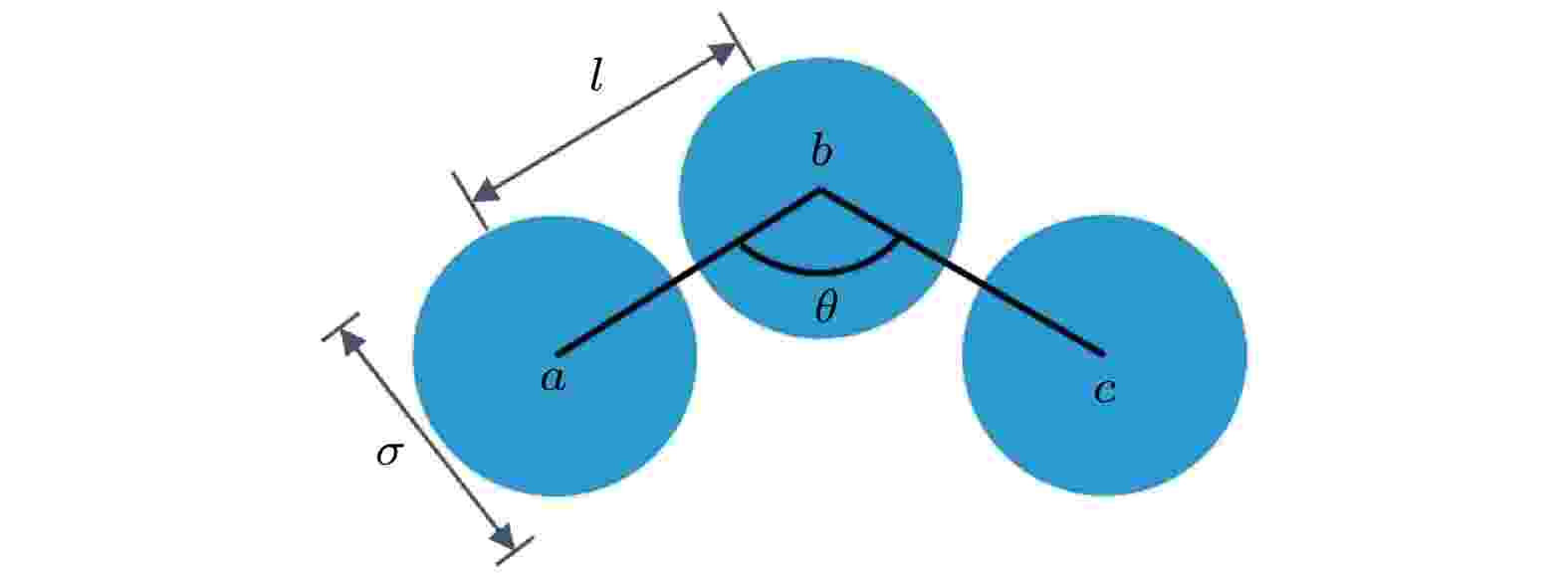
2021, 70 (12): 126401.
doi:10.7498/aps.70.20210128
Abstract +
Colloidal polymers have attracted increasing attention in condensed physics, statistical mechanics and polymer science and engineering due to their advances in synthesis and visualization. Many useful properties and applications of colloidal polymers make them an ideal model to explore fundamental problems in slow dynamics and rheology of chain-like molecules in supercooled regime. With temperature decreasing or density rapidly increasing, amorphous materials often exhibit nonzero shear moduli. In this article, we are to investigate the nonzero shear modulus and bulk modulus of colloidal polymer in supercooled regime based on recent microscopic theoretical development. At the segmental-scale level, an analytical derivation for elastic modulus of colloidal polymer is constructed based on the standard approximation in naïve mode-coupling theory (NMCT). In the framework of nonlinear Langevin equation theory (NLET), the derivation combines the concept of dynamic free energy, localization and NMCT crossover volume fraction. Taking the chain connectivity into account, an explicit expression for shear modulus including intrachain structure factor, interchain correlation and localized length is formulated. Bulk modulus can be obtained by relating it to long wavelength part of static structure factor. Firstly, our calculation for discrete wormlike chain shows that intrachain structure factor has a power law decay at intermediate wavevector which is similar to flexible linear chain. Secondly, we find that colloidal polymer with long bond length has a lower NMCT crossover volume fraction. Furthermore, inputting the localized length, long wavelength density fluctuation and static intrachain and interchain structures into the theoretical expression, the effect of bond length on shear modulus and bulk modulus are investigated. Interestingly, we find the bond length plays a critical and unique role in localized length and bulk modulus. For instance, when the supercooling degree is used as an independent variable, the local length and bulk elastic modulus of the chain with the same bond length can be collapsed onto a universal curve, which is independent of chain length and local bending energy. However, in the aspect of shear modulus, the bond length is not a unique quantity and the above universal curve cannot be found. The shear modulus depends on other parameters of chain, such as chain length and rigidity. According to the universal behavior of zero-wavevector static structure factor versus bond length, we guess that the nonuniversal curve of shear modulus is due to the bond length effect on long wavevector static structure factor. This work provides a theoretical foundation for controlling various properties of chain-like supercooled materials in the future.
CONDENSED MATTER: ELECTRONIC STRUCTURE, ELECTRICAL, MAGNETIC, AND OPTICAL PROPERTIES
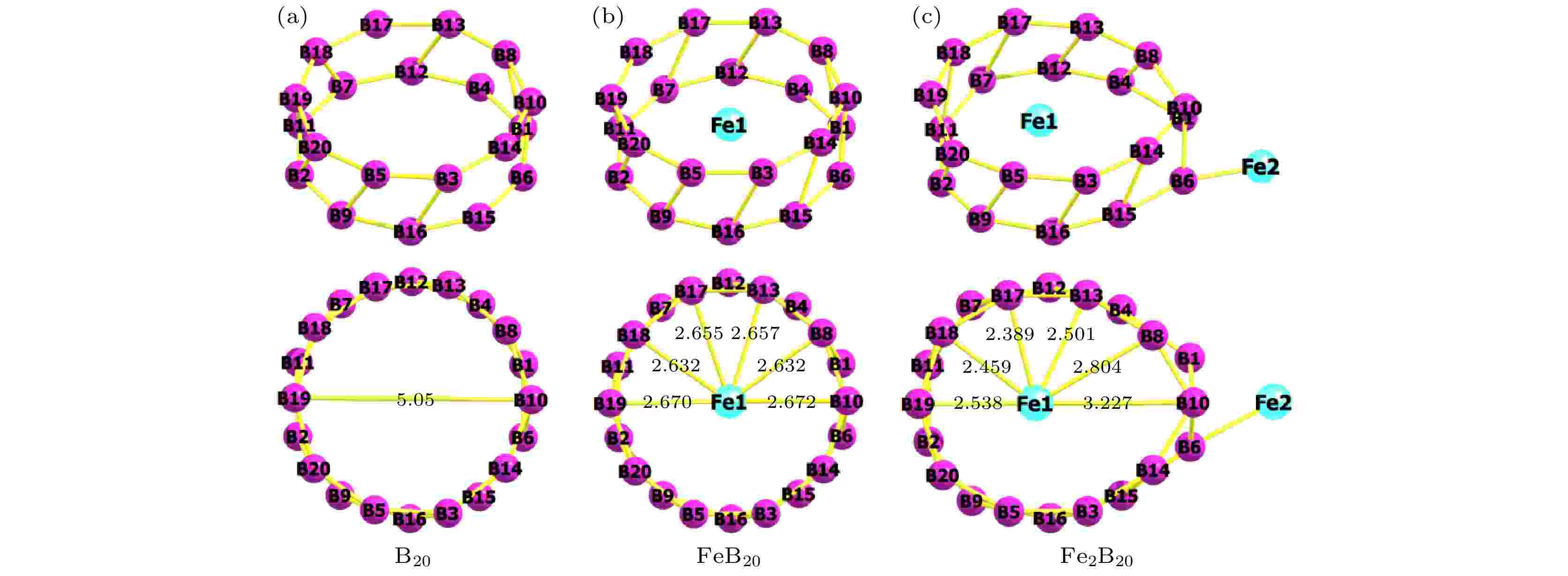
EDITOR'S SUGGESTION
2021, 70 (12): 127505.
doi:10.7498/aps.70.20210056
Abstract +
In this study, we use first-principles calculations to investigate the geometry, the electronic and the magnetic structure as well as to propose the laser-induced ultrafast spin dynamics on the tubular FeB20and Fe2B20clusters. Our results show that the FeB20is a stable configuration when its Fe atom gets preferably adsorbed inside the B20tube, while the Fe2B20is more stable configuration when one of its two Fe atoms is located inside and the other outside the boron tube. In the latter cluster, due to the higher number of d states introduced by the additional magnetic atom, the density-of-states in the low-energy region becomes higher, thus leading to richer spin dynamics. The different local geometries of the two Fe atoms lead to a multitude of many-body states with high degree of spin-density localization. Based on the calculated ground state and excited states and by using suitably tailored laser pulses we achieve ultrafast spin-flip and spin crossover scenarios for both structures. Besides, the spin-flips reach a high fidelity (above 89.7%) and are reversible, while the crossovers have lower fidelity (below 78%) and are irreversible. We also propose an ultrafast spin-transfer process from Fe2 to Fe1 for Fe2B20. The present investigation, in which we predict various ultrafast spin dynamic taken by magnetic atoms absorbed inside and outside of tubular boron clusters, is expected to provide significant theoretical guidance for the future experimental implementation and the potential applications of the relevant spin logic functional devices.

2021, 70 (12): 127701.
doi:10.7498/aps.70.20202164
Abstract +
Exploring phase transition behaviors and constructing phase diagrams are of importance for theoretically and experimentally studying ferroelectric physics and materials. Because of the rapid development of computers and artificial intelligence, especially machine learning methods combined with other computational methods such as first principle calculation, it is possible to predict and choose appropriate materials that meet the target requirements from a large number of material data, which greatly saves the cost of experiments. In this work, we use neural network method and phenomenological theoretical calculations to accurately predict the phase structures that may appear in the phase diagrams of different orientated Pb(Zr0.52Ti0.48)O3ferroelectric films, and establish the temperature-strain phase diagrams of (001), (110) and (111) oriented thin film, and calculate the polarization and dielectric properties of different oriented films at room temperature. By analyzing the changes of prediction accuracy and loss with the number of iterations, it is found that the deep neural network method has the advantages of high accuracy and speed in the construction of the film temperature-strain phase diagram and the prediction of the types of phases. Through the analysis of the room temperature polarization and dielectric properties, it is found that the (111)-oriented PbZr0.52Ti0.48O3film has the largest out-of-plane polarization and the smallest out-of-plane dielectric coefficient, and they are insensitive to misfit strain. This work provides guidelines for designing micro-nano devices that require the stable dielectric coefficient and polarization performance in the special working environment and operation.

2021, 70 (12): 127702.
doi:10.7498/aps.70.20210115
Abstract +

2021, 70 (12): 127901.
doi:10.7498/aps.70.20210106
Abstract +
The potential, unexpected occurrence of dielectric multipactor on the dielectric surfaces in high-power radio frequency and microwave components has become a severe constraint in the research and development of space-borne payloads of space vehicles such as satellites and space stations on the ground and their long-term reliable operations in the orbit. In this experimental research, the single-surface multipactor occurring on the dielectric surface of a penetration flange originally designed for a vacuum chamber used in environmental simulation tests of spacecraft is experimentally investigated and compared with the corresponding full-wave simulated results. Under the excitation of periodic pulsed sinusoidal signals, the unusual experimental phenomena of intermittent local jumps of nulling signals in the process of multipactor are repeatedly observed based on an agile nulling experimental system. Taking advantage of the full-wave, three-dimensional (3D) particle-in-cell simulation tool, CST Particle Studio, the entire evolution process of the dielectric multipactor, from its onset to its saturation, is simulated and carefully examined. Combining the results obtained by full-wave 3D particle simulations, some physical explanations and discussion on such phenomena are presented. It is found that under the configuration parameters of pulse signals adopted in this multipactor experiment, the transition of a single-surface dielectric multipactor from its onset to the saturation state can be finished within a single pulse. However, its transition from the saturation state to turning off can last between consecutive pulses in the absence of any high-power radio frequency signals. The obtained result is important for both the theoretical study and the engineering development of high-power dielectric components, providing a new understanding of the dielectric multipactor occurring under the excitation of pulsed high-power electric fields.
INTERDISCIPLINARY PHYSICS AND RELATED AREAS OF SCIENCE AND TECHNOLOGY

2021, 70 (12): 128101.
doi:10.7498/aps.70.20202163
Abstract +

2021, 70 (12): 128401.
doi:10.7498/aps.70.20201852
Abstract +
Cu1.8S-based materials have become potential thermoelectric materials due to their rich raw material reserves, low toxicity, and excellent electrical and thermal properties. In this study, a series of Cu1.8–xSbxS (x= 0, 0.005, 0.02, 0.03, 0.04) bulk materials is synthesized by using mechanical alloying combined with spark plasma sintering process. This preparation method can shorten the preparation cycle of materials, and effectively improve the research and development efficiency of thermoelectric (TE) materials due to its simple process. The effects of different Sb doping amounts on the structure, micromorphology, and thermoelectric transport properties of Cu1.8–xSbxS phase are investigated. The results show that when 0 ≤x< 0.02, the bulk samples are single-phase Cu1.8S. With the further increase of Sb doping to 0.02 ≤x≤ 0.04, the second phase CuSbS2is formed when Sb content exceeds the solid solubility limit ofx= 0.02 in Cu1.8S, all Cu1.8–xSbxS bulk samples exhibit p-type conductivity characteristics. Benefitting from the synergistic phonon scattering effect by multiscale defects, such as point defects (
${\rm{Sb}}_{{\rm{Cu}}}^{ \bullet\bullet }$
,
$ {\rm{V}}_{\rm{S}}^{ \bullet \bullet } $
), nanopores, secondary phases (CuSbS2), and dislocations, the thermal conductivityκdeclines significantly from 1.76 W·m–1·K–1(x= 0) to 0.99 W·m–1·K–1at 723 K for the Cu1.76Sb0.04S sample. Finally, the peak dimensionless TE figure of merit (ZT) value of 0.37 is achieved at 723 K for Cu1.77Sb0.03S resulting from a low thermal conductivity of 1.11 W·m–1·K–1combining an appropriate power factor of 563 μW·m–1·K–2, which is 12% higher than that (0.33) of pristine Cu1.8S. Although the Sb doped Cu1.8S-based samples have lower thermal conductivityκ, the reduced power factor cannot be offset by reducing the thermal conductivityκ, so the TE figure of merit (ZT) value is not significantly improved. Therefore, there is still much room for improving the performance of Sb doped Cu1.8S-based thermoelectric material, and its thermoelectric performance can be further optimized through nano-second phase recombination, energy band engineering, and introducing multi-scale defects, etc. Our results suggest that the introduction of Sb into thermoelectric materials is an effective and convenient strategy to improveZTvalue by reducing thermal conductivityκ.
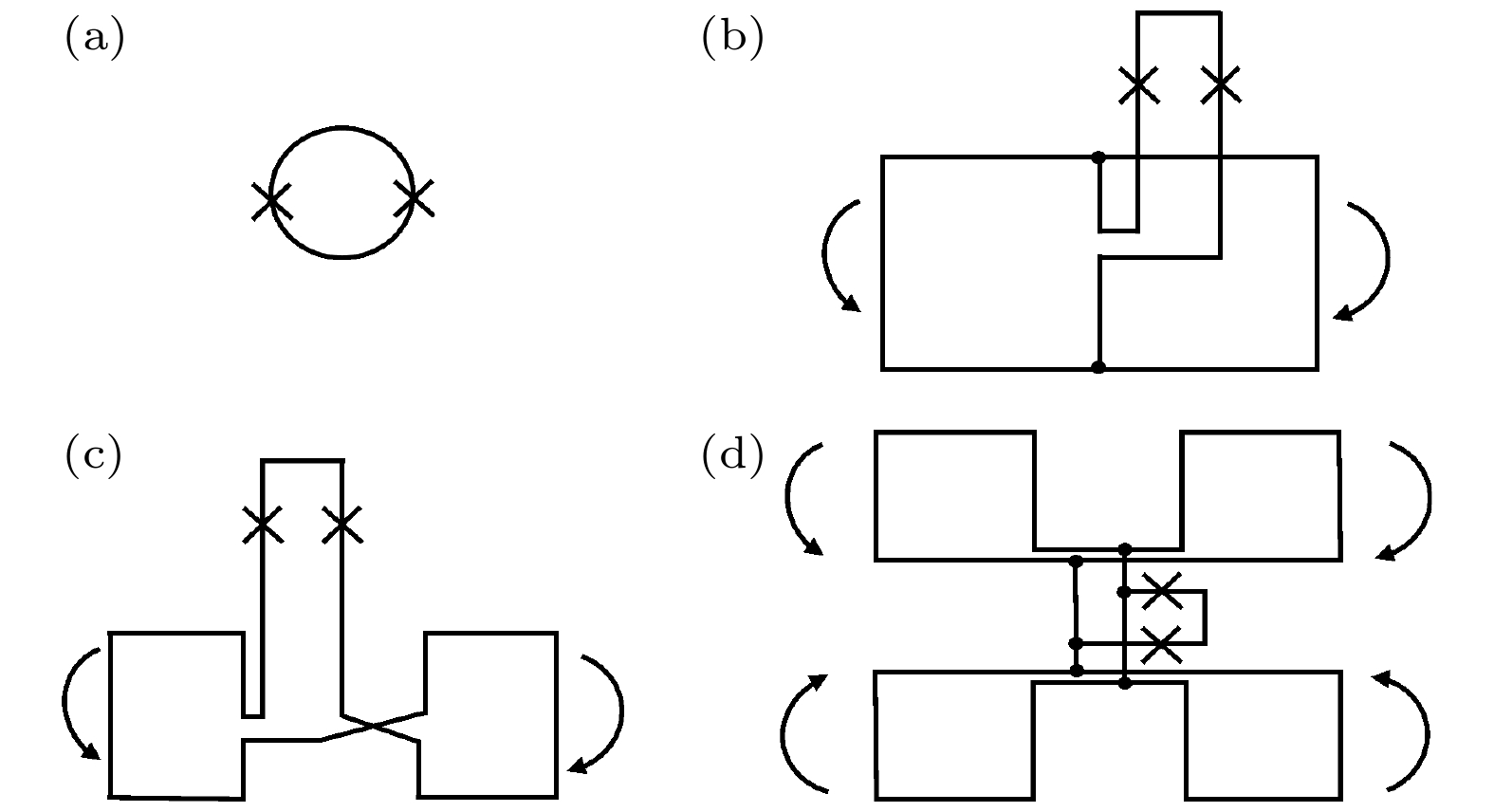
2021, 70 (12): 128501.
doi:10.7498/aps.70.20201816
Abstract +
Superconducting quantum interference device (SQUID) has extremely high magnetic field sensitivity, current sensitivity, and can detect a low-noise weak current signal. The SQUID current sensor has become the only option of the readout of low-noise detector, such as transition-edge sensor (TES). In this paper, a second-order gradiometric cross-coupled SQUID current sensor for TES application is developed. According to the requirements for TES detectors, the structure and various parameters of SQUID current sensor are designed. The SQUID loop, input coil and feedback coil of the SQUID current sensor all use the second-order gradiometric structure. All the couple ways between SQUID loop and input coil or feedback coil adopt cross-coupling mode in different planes, which can effectively weaken the parasitic capacitance. A second-order gradiometric cross-coupled SQUID current sensor based on Nb/Al-AlOx/Nb Josephson junction is successfully fabricated on a silicon wafer by optimizing the process. The properties of the second-order gradiometric cross-coupled SQUID current sensor are measured at liquid helium temperature. The bias current of SQUID is 215 μA when the modulation depth ofV-Φmodulation curve is maximum. The maximum modulation peak of SQUID is 31 μV. The flux-to-voltage transfer coefficient of SQUID is 108 μV/Φ0. The input coil current sensitivity is 17 μA/Φ0, the mutual inductance between SQUID loop and input coil is 117 pH. The current sensitivity of feedback coil is 86 μA/Φ0, the mutual inductance between SQUID loop and feedback coil is 23 pH. The second-order gradiometric cross-coupled SQUID current sensor has a white flux noise of 2 μΦ0/
$ \sqrt{{\rm{H}}{\rm{z}}} $
and a white current noise of 34 pA/
$ \sqrt{{\rm{H}}{\rm{z}}} $
with 1/fcorner frequency around 200 Hz. The result of noise level under the condition without magnetic shielding shows that the SQUID current sensor with second-order gradiometric cross-coupled structure has an excellent capability of weakening the environmental electromagnetic interference. In the future, we will further improve the mutual inductance of the second-order gradiometric cross-coupled SQUID current sensor between SQUID loop and input coil, optimize the size and critical current of Josephson junction, in order to improve the input sensitivity of SQUID device, reduce the current noise level and the 1/fcorner frequency, and meet more requirements for TES applications.
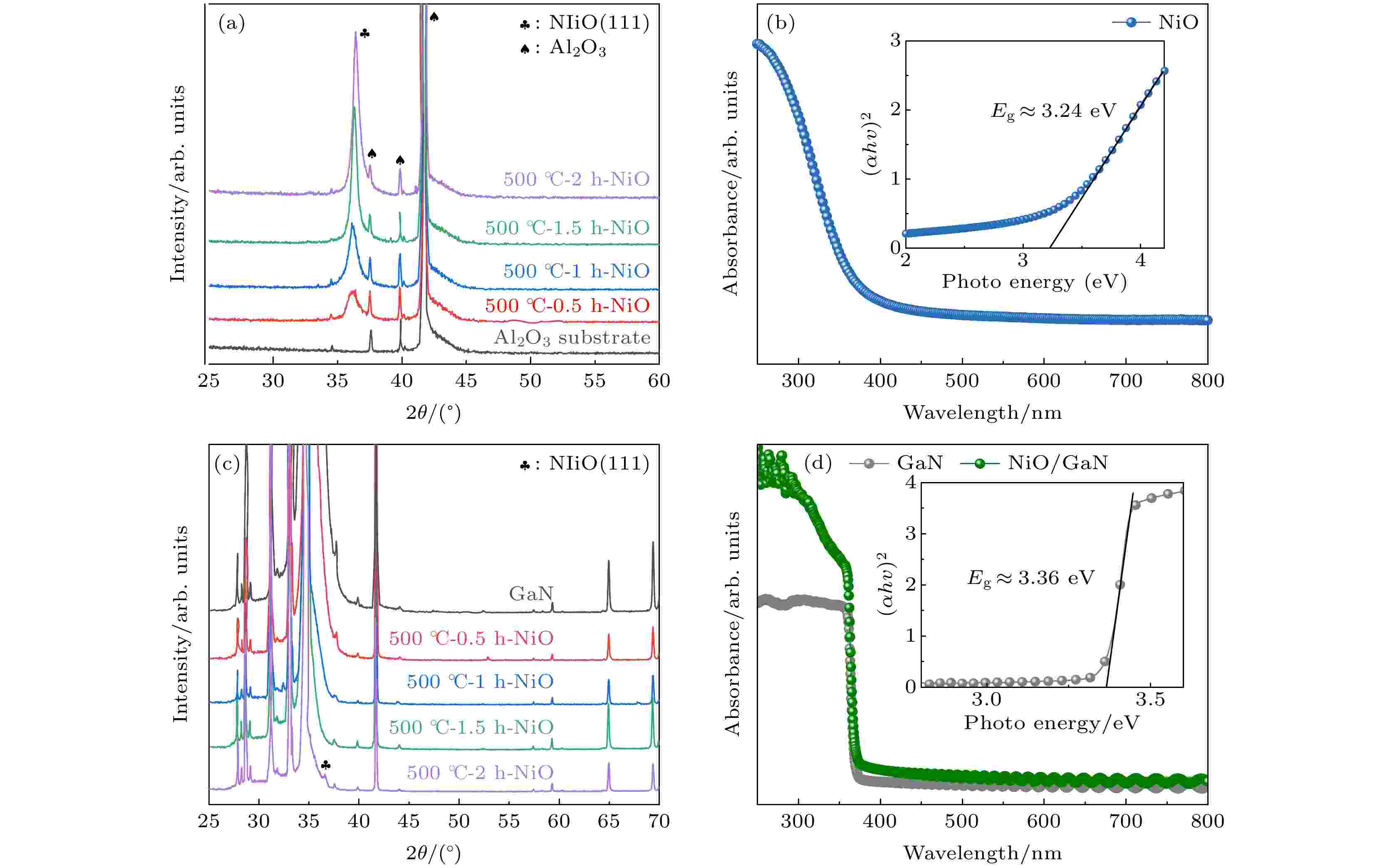
2021, 70 (12): 128502.
doi:10.7498/aps.70.20210154
Abstract +
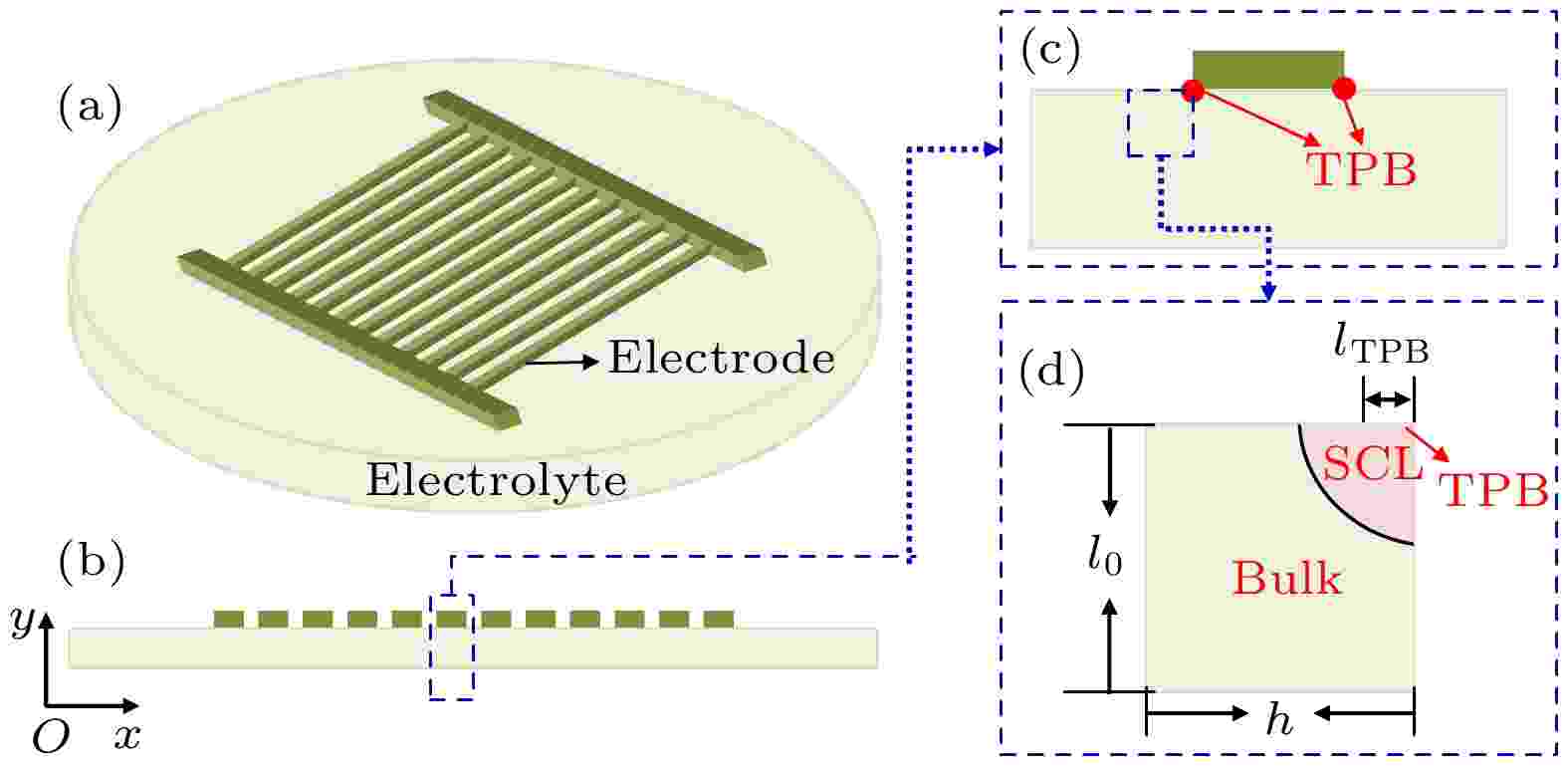
2021, 70 (12): 128801.
doi:10.7498/aps.70.20210012
Abstract +
The nanocomposite electrode is a promising technology to improve the electrochemical performance of intermediate/low temperature solid oxide fuel cells (SOFCs). Within the nanocomposite electrode, the space charge layer (SCL) effect is likely to alternate the oxygen vacancy transport adjacent to the three phase boundaries (TPBs), which is one of the key factors to improve the electrochemical performance of the electrodes. Existing studies usually adopt Poisson-Boltzmann (PB) equation to predict the SCL effect, in which all the charge carriers are assumed to be in the electrochemical equilibrium state and the net current of the conductor is nearly zero. Apparently, the PB equation is incapable of predicting the SCL effects under typical SOFC operating conditions, since the net current is obviously not zero. In this paper, based on the patterned electrode, we develop a numerical method via coupling the Poisson equation with the mass conservation equation of charge carriers for the oxygen vacancy transport with considering the SCL effect under SOFC operating conditions. Our results show that an obvious gradient is observed in the oxygen vacancy concentration near the TPBs due to the SCL effect, which leads to a remarkable diffusion current that is even larger than the migration current driven by the potential gradient. The SCL resistance is computed to quantitatively characterize the influence of the SCL effect on the oxygen vacancy transport. The SCL resistance shows a decreasing tendency with the increasing of the dimensionless Debye length and dimensionless potential, but it increases with the increasing of the dimensionless average current density. These results and the numerical method can be helpful in improving the performance of intermediate/low temperature SOFCs via rationally designing robust nanocomposite electrodes.
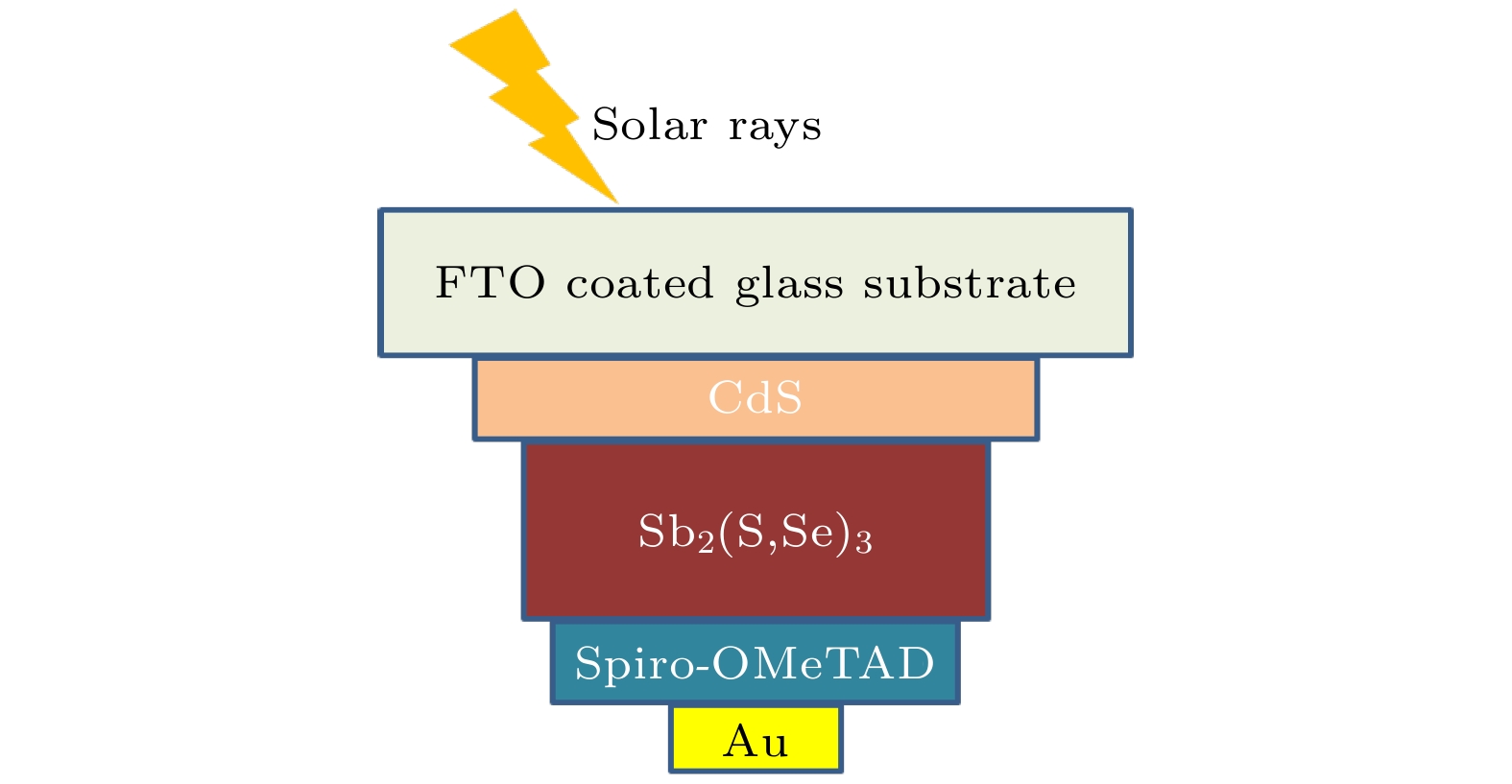
2021, 70 (12): 128802.
doi:10.7498/aps.70.20202016
Abstract +
Sb2(S,Se)3thin film solar cells have been developed rapidly in recent years due to their abundant raw materials, simple preparation method, stable performance, etc. In this study, based on the characteristic of tunable band gap of Sb2(S,Se)3light absorption layer, wx-AMPS software is used to simulate and design the Sb2(S,Se)3solar cell with narrowing band gap structure, and compared with the Sb2(S,Se)3solar cell with constant band gap (50% selenium content). The results show that the additional electric field formed by the narrowing band gap can promote the holes’ transport and inhibit the carrier’s recombination. Compared with the constant band gap structure, the narrowing band gap structure can increase the short-circuit current density of Sb2(S,Se)3solar cells from 19.34 to 22.94 mA·cm–2, the filling factor from 64.34% to 77.04%, and the photoelectric conversion efficiency from 12.03% to 14.42%. Then, the effect of electron mobility on the performance of Sb2(S,Se)3solar cells with narrowing band gap is studied. It is found that when the hole mobility is 0.1 cm2·V–1·s–1, the advantage of narrowing band gap can gradually appear after the electron mobility is higher than 0.25 cm2·V–1·s–1. The performance of Sb2(S,Se)3solar cell is enhanced with the electron mobility further increasing. However, when the electron mobility is higher than 5 cm2·V–1·s–1, the device performance is saturated. Moreover, we demonstrate that the degradation caused by thick or high defect state of Sb2(S,Se)3solar cell can be effectively alleviated by applying the narrowing band gap due to the suppression of the carrier recombination. When the thickness is 1.5 μm and the defect density is 1016cm–3, the photoelectric conversion efficiency of Sb2(S,Se)3solar cell with narrowing band gap is 6.34% higher than that of the constant bandgap. Our results demonstrate that the band gap engineering of the light absorption layer is one of the effective technical routes to optimizing the performance of Sb2(S,Se)3solar cells. Since the photo-absorption material such as amorphous/microcrystalline silicon germanium, Copper indium gallium selenide and perovskite have the characteristic of tunable band gap. The design of the gradient band gap structure can also be applied to the optimization of the above alloy or compound solar cells.
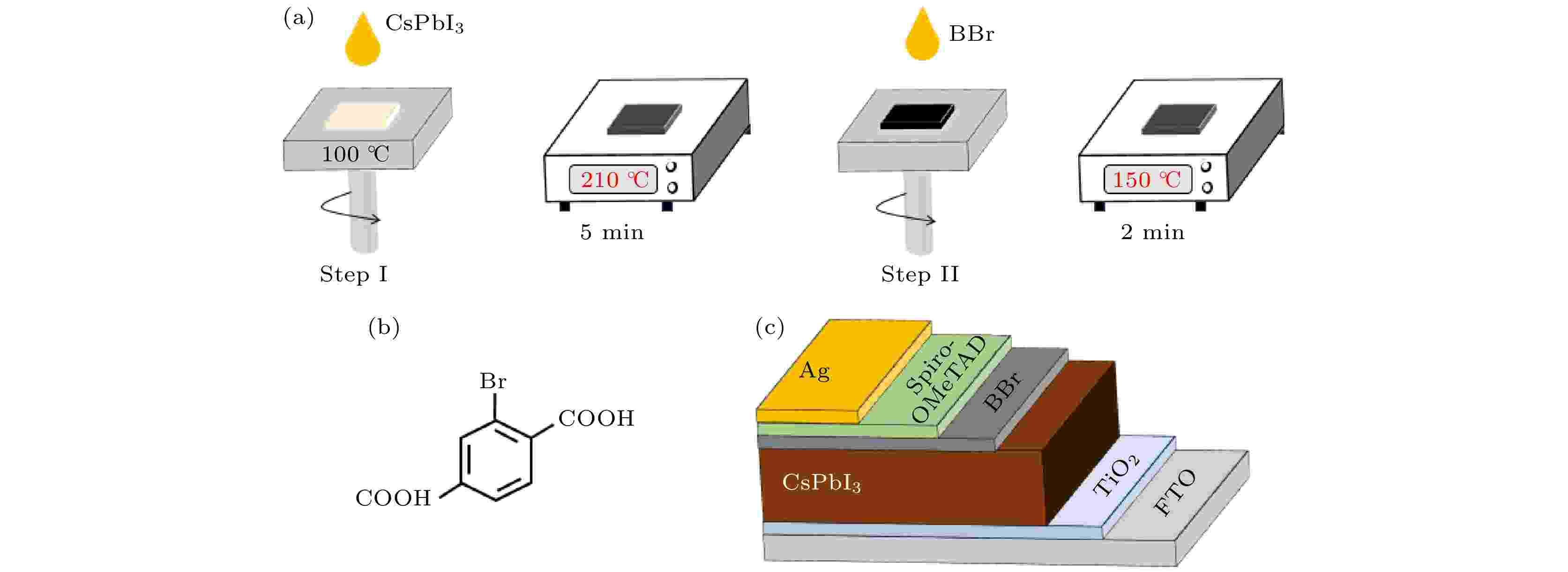
2021, 70 (12): 128803.
doi:10.7498/aps.70.20202005
Abstract +
All-inorganic perovskite cesium lead iodine (CsPbI3) without any volatile organic components has attracted much attention due to its superior stability, high absorption efficiency and suitable band gap. However, the power-conversion efficiencies of CsPbI3based perovskite solar cells (PSCs) are substantially low compared with those of the organic-inorganic hybrid lead halide PSCs. The surface passivation of the CsPbI3film by long-chain halide salts has been found to be an effective method of improving the performance. In this paper, we report the concentration effect of an inexpensive 2-bromoterephthalic acid (BBr) as passivation material on the performance of CsPbI3perovskite solar cells. The experimental results show that the conversion efficiency of perovskite solar cells first increases and then decreases as the concentration of BBr increases from 0 to 2 mg/mL. The best conversion efficiency of CsPbI3perovskite solar cells reaches 13.5% at 0.2 mg/mL BBr. The results from X-ray diffraction and scanning electron microscopy suggest that there is no change in the phase or microstructure of the CsPbI3perovskite film after surface passivation by BBr. By further analyzing the photoluminescence data of the CsPbI3film with and without capping hole transport layer, it can be found that the passivation of BBr with the concentration of 0.2 mg/mL can enhance the fluorescence excitation intensity of the CsPbI3film and accelerate the exciton separation at the interface between CsPbI3film and hole transport layer. Based on the electrochemical impedance spectroscopy data, we find that the electron transport ability at the interface between TiO2and CsPbI3can be significantly improved after surface passivation, which is induced by the acceleration of the exciton separation at the interface between CsPbI3film and hole transport layer. The decrease of the PSCs performance when the concentration of the BBr precursor increases from 0.5 mg/mL to 2 mg/mL can be attributed to the local agglomeration of the BBr material, resulting in the block of charge transportation. This research is expected to provide basic support for the low-cost development of the passivation materials for perovskite solar cells.





















